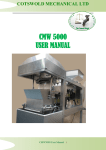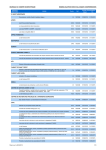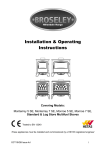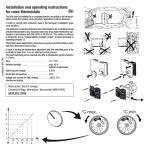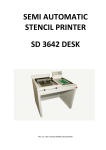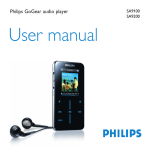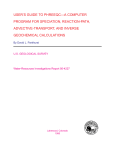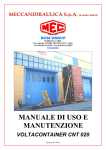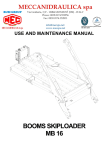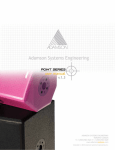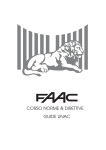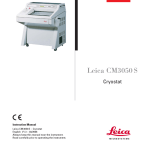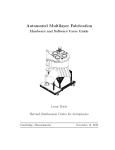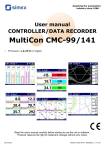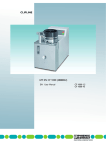Download CMW 2000 USER MANUAL - Cotswold Mechanical Handling
Transcript
COTSWOLD MECHANICAL LTD CMW 2000 USER MANUAL COTSWOLD MECHANICAL LTD Unit 4, Chancel Close, Eastern Avenue, Gloucester, GL4 3SN TEL: (01452) 309944 FAX: (01452) 306644 http://www.cotsmech.co.uk Email: enquiries@cotsmech.co.uk 1 COTSWOLD MECHANICAL LTD Table of Contents: Page Number: Title & Description: 1 2. 3. 4. 6. 7. 8. 9. 10. 15. 16. 17. 18. 19. 74. 79. 90. 92. 97. 103. 107. 108. 114. Cover Page Table of Contents CMW2000 – Basic Overview Basic on Machine Overview Hints Successful Operation CMW2000 Overview 1. CMW2000 Overview 2. CMW2000 Overview 3. Product Feed Hopper Vibratory Feed System Gating System Outlet Chute Load-cell Top Box Weigh-Pan CMW Control System Variable Frequency Vibrator Option V1 & V2 Vibrator Units Optional Data Recorder Cleaning Schedule Maintenance Schedule Pneumatics Technical Details Electrical Drawings Parts Book & Spares COTSWOLD MECHANICAL LTD Unit 4, Chancel Close, Eastern Avenue, Gloucester, GL4 3SN TEL: (01452) 309944 FAX: (01452) 306644 http://www.cotsmech.co.uk Email: enquiries@cotsmech.co.uk 2 COTSWOLD MECHANICAL LTD Basic Overview: Cotswold Mechanical’s entire range of weighing machines have the same basic mode of operation and whilst the format, style, size and specification may differ to suit different products, weights and speed requirements basic principles are valid throughout. 1. Product is placed into a holding hopper and is then fed automatically, at a fast speed, into a pan that is attached to a weighing mechanism until the target weight is almost reached at which point the feed rate slows to a trickle. On achieving the required weight feed stops altogether and, after checking that the weight is correct, the weighed product is released into a waiting container. 2. The product infeed hopper normally has adjustable gates to regulate the depth of product allowed out on to the feed system 3. The feed system normally comprises a series of vibratory feeders (sometimes referred to as feed trays) 4. There are normally two vibratory feeders; one to take the bulk product out of the hopper (bulk or primary tray) and one to feed the product under strict control into the weighpan (fine or secondary tray). The exception to this is the CMW2000 which only uses one vibratory feed tray. 5. At the outfeed end of the feed system there are normally some “gates”. These are designed to assist in the precise feed of the product. In the case of the bulk gate, this closes to shut off the bulk feed tray when “fine” feed is taking place. Similarly, the fine feed gate closes when the correct weight is in the weighpan making sure that no further product is allowed in, thus minimizing the possibility of over-weights being produced. Again, the CMW2000 is an exception, only using one gate. This acts to shut off the bulk flow of product. Fine feed of product is achieved by product ‘spilling’ around the shut bulk gate, and the feed tray running at low speed. 6. The type and design of feed system is determined by the characteristics of the product to be handled. 7. A suitable receptacle is placed beneath the Outlet Chute of the machine – usually specified by the machine operator. When the correct signal is given, (usually via an operator footswitch or ancillary piece of equipment such as a vertical form fill and seal bagmaker), weighed product is discharged down the Outlet Chute and into the waiting container. 8. The weighing function of the machine is performed by a precision weighing mechanism (normally a loadcell) 9. The gating system is located above a chute that transfers the product into the container to be filled. These outlet chutes are designed to suit the application and may be fitted with different size and style of extensions to adapt them to various sizes and styles of packaging. 10. All aspects of the machine operation including, target, bulk and fine weights, the speed (amplitude) of the vibratory feeders, the frequency of the auto-tare facility etc. are all set and held in the “Product Code Memory” of the control system - along with all other information necessary for the correct operation of the machine. 11. Once the correct settings for a particular product and weight combination have been determined they can be retained in the control system memory and simply recalled the next time they are required to be used. COTSWOLD MECHANICAL LTD Unit 4, Chancel Close, Eastern Avenue, Gloucester, GL4 3SN TEL: (01452) 309944 FAX: (01452) 306644 http://www.cotsmech.co.uk Email: enquiries@cotsmech.co.uk 3 COTSWOLD MECHANICAL LTD Hints on Successful Operation: THE SECRET OF ACCURATE AUTOMATIC WEIGHING IS IN OBTAINING A CORRECT AND RELIABLE PRODUCT FEED INTO THE BOX OR CONTAINER. 1. The amount of product on the bulk (primary) tray is determined by: i) The position of the adjustable sliding gate on the front of the hopper. The correct position of this gate is determined by: a) The type of product being handled b) The throughput and depth of product deemed necessary 2. The level of product on the fine (secondary) tray is determined by: i) The position of the adjustable sliding gate on the front of the hopper. The correct position of this gate is determined by: a) The type of product being handled b) The throughput and depth of product deemed necessary IT IS ESSENTIAL TO HAVE A SMALL - BUT SUFFICIENT – FINE FEED. 3. If there is none, or it is too little, invariably over-weights will be produced. i) If it is too long product may build up behind the bulk gate resulting in erratic weights (correct weight followed by an overweight etc.) FINE FEED TOO SHORT - DECREASE the BULK WEIGHT SETPOINT FINE FEED TOO LONG - INCREASE the BULK WEIGHT SETPOINT 4. It is important that the depth and speed of movement of the product are in keeping with the weight being made and the accuracy required. In general the higher the target weight and the smaller the product piece size the greater the depth of product and the faster the movement can be. It is impossible to give exact advice on actual settings, they will only be determined by running the actual product through the machine and by using trial and error along with experience gained in the best method of operation for your own particular products and requirements. COTSWOLD MECHANICAL LTD Unit 4, Chancel Close, Eastern Avenue, Gloucester, GL4 3SN TEL: (01452) 309944 FAX: (01452) 306644 http://www.cotsmech.co.uk Email: enquiries@cotsmech.co.uk 4 COTSWOLD MECHANICAL LTD Hints on Successful Operation: (Continued) Before starting the machine: Set the desired Target weight (Example 1000g) Set the Fine set point to equal the Target Weight (Example 1000g) Set the Bulk set point to Target Weight minus 10% (Example 900g) Set the Fine vibrator fast speed to 50% and the slow speed to 40% Set the Bulk vibrator fast speed to 40% Switch the machine in to run mode. Place a small amount of product in to the Fine vibrator tray; check the product is transferred along the vibrator with a smooth and consistent flow rate. If the transfer of product is too slow or too fast adjust the Fine vibrator fast and slow speeds accordingly. Place a small amount of product in to the Bulk vibrator tray; check the product is transferred along the vibrator with a smooth and consistent flow rate. If the transfer of product is too slow or too fast adjust the Bulk vibrator fast speed accordingly. Stop the machine Close the hopper slide gate, and then fill the hopper with product. Now open the hopper slide gate, only a sufficient amount to allow the product to flow from the gate. Re-start the machine. Bulk Cut-off Weight---range 0 – target weight Enter the weight at which the vibrators will switch from fast to slow feeding. Fine Cut-off Weight--------range 0 – target weight Enter the weight at which the vibrators will stop feeding and the weigher start to settle. Use the COPY button to copy the entered settings to all weighers. COTSWOLD MECHANICAL LTD Unit 4, Chancel Close, Eastern Avenue, Gloucester, GL4 3SN TEL: (01452) 309944 FAX: (01452) 306644 http://www.cotsmech.co.uk Email: enquiries@cotsmech.co.uk 5 COTSWOLD MECHANICAL LTD Machine Overview- 1: Product Feed Hopper Vibratory Feed System Gating Assembly Outlet Chute Assembly CMW Controls COTSWOLD MECHANICAL LTD Unit 4, Chancel Close, Eastern Avenue, Gloucester, GL4 3SN TEL: (01452) 309944 FAX: (01452) 306644 http://www.cotsmech.co.uk Email: enquiries@cotsmech.co.uk 6 COTSWOLD MECHANICAL LTD Machine Overview – 2: Loadcell Box Assembly Weighpan Assembly COTSWOLD MECHANICAL LTD Unit 4, Chancel Close, Eastern Avenue, Gloucester, GL4 3SN TEL: (01452) 309944 FAX: (01452) 306644 http://www.cotsmech.co.uk Email: enquiries@cotsmech.co.uk 7 COTSWOLD MECHANICAL LTD Machine Overview – 3: Description: A single lane automatic linear weighing machine which utilises the highest quality components and materials and combines a precision loadcell weighing mechanism with the latest electronic technology. Weight Range: 0.5kg upto 2.0kg, although versions may vary. Applications are also dependent on the product bulk density. Capacity: Upto 4.5 litres per weighment depending on application - versions may vary Function: The machine utilises a hopper system that is filled with the product to be weighed. By means of a vibrating tray, product is fed in a controlled manner to the weigh-pan assembly. A pneumatically actuated gate ensures that the weigh-pan is filled to the correct target weight with no excess product overspill. The product weights are continuously monitored by the electronic controls, and once the target weight has been achieved, the weigh-pan pneumatically discharges the weighed product upon receipt of an electronic volt free signal. This is usually done via an operator footswitch, or is given by an ancillary piece of equipment such as a vertical form fill and seal bag-maker. Alternatively, the machine can give an output volt free signal to indicate that a weight is complete and ready for discharge. As the weigh-pan discharges, the product falls down a chute that is usually custom made to suit an individual application. This ensures that the weighed product falls into a suitable receptacle placed or positioned beneath the outlet chute. Machine Overview: The CMW2000 comprises of the following sub-assemblies: 1. 2. 3. 4. 5.. 6. 7. Product Feed Hopper……………………… Vibratory Feed System ……………………. Gating Assembly………………………….. Outlet Chute Assembly…………………….. CMW Controls…………………..…………. Loadcell Box Assembly)…………………... Weighpan Assembly ………………………. COTSWOLD MECHANICAL LTD Unit 4, Chancel Close, Eastern Avenue, Gloucester, GL4 3SN TEL: (01452) 309944 FAX: (01452) 306644 http://www.cotsmech.co.uk Email: enquiries@cotsmech.co.uk 8 COTSWOLD MECHANICAL LTD Product Feed Hopper: Product Feed Hopper (x1) Hopper Gate Adjusting Hand wheel (x2) Hopper Gate (x1) Note: Some Hoppers are fitted with various sound deadening panels as an optional extra to dampen product noise when product enters the hopper. These panels are permanently adhered and sealed to the Hopper. Under no circumstances should they be removed. The Product Hopper is usually custom designed to suit the individual product requirements. It is normally mounted by means of four bolts into the top of the machine frame. Product feed from the hopper is controlled via a hopper feed control gate. The volume and depth of product that exits the hopper can be adjusted by loosening the hand-wheel then raising or lowering the hopper slide gate and re-tightening the hand-wheel once the correct level has been achieved. Normally this is set to the minimum gap that will allow the product to flow freely from the hopper. Due to the fact that the Hopper is bolted to the machine frame, it is normally cleaned in position and not intended for removal. COTSWOLD MECHANICAL LTD Unit 4, Chancel Close, Eastern Avenue, Gloucester, GL4 3SN TEL: (01452) 309944 FAX: (01452) 306644 http://www.cotsmech.co.uk Email: enquiries@cotsmech.co.uk 9 COTSWOLD MECHANICAL LTD Vibratory Feed System: Feed Tray V1 Vibrator Unit The Vibratory Feed System: The system comprises a vibratory feed tray mounted on an electromagnetic vibrator. During normal operation, the tray transfers product in a controlled fashion from the product hopper to the weighpan via a pneumatically controlled bulk gate. The tray has two product feed speeds; fast or bulk speed and slow or fine speed. Typically, when a new weighment of product is to be made, the tray operates at fast speed so that the majority of product enters the weighpan in the shortest possible time. As the weighment approaches the target weight, the feed tray switches to the slow or fine feed to fill up the weighpan with the last minority of product required to achieve the target weight. The Feed Tray is manufactured from high grade 304 food quality stainless steel and is permanently attached to the vibrator unit. The Tray will easily withstand cleaning with most food standards approved cleaning agents. COTSWOLD MECHANICAL LTD Unit 4, Chancel Close, Eastern Avenue, Gloucester, GL4 3SN TEL: (01452) 309944 FAX: (01452) 306644 http://www.cotsmech.co.uk Email: enquiries@cotsmech.co.uk 10 COTSWOLD MECHANICAL LTD Vibratory Feed System: (Continued) Method Of Adjustment: (See CMWControl Instruction Manual, Product Feed Section 3.4 ) Each Vibrator has two speed settings, fast and Slow speeds. Each speed is digitally set within the Product Code Menu, values 0-100% Fast Speed: This speed settings is used to when feeding the majority (Bulk) of the product through the feed system and in to the Weighing system. Normally the Primary Vibrator, this will allow thinning of the level of product as it progresses through the system. Example: Primary fast speed = 45%. The Fast Speeds continue to be used until the “Bulk” set point is achieved. Slow Speed: This speed settings is used to when feeding the final (Fine) or top up of the product to achieve the desired target weight. . Example: Primary slow speed = 40% The Slow Speeds continue to be used until the “Fine” set point is achieved. The “Fine” set point is normally set to slightly below the desired target weight, this allows for product in flight. If the “Fine” set point value is set low the system will stop early and the target weight will not be achieved. The feed system will then begin to top up, again using the slow speed settings. Fast Speed Slow Speed COTSWOLD MECHANICAL LTD Unit 4, Chancel Close, Eastern Avenue, Gloucester, GL4 3SN TEL: (01452) 309944 FAX: (01452) 306644 http://www.cotsmech.co.uk Email: enquiries@cotsmech.co.uk 11 COTSWOLD MECHANICAL LTD Vibratory Feed System: Vibrator Tuning Top Plate (x1) Fig. 1 Typical V1 Vibrator Assembly Springs: 7 ply 9 ply 11 ply V1 Drive Head Clamp Spacer Base Plate (V1) Vibrator Rubber Over a period of time, the performance of the V1 Vibratory feed unit may diminish. This is usually after a period of eight months or more and is more noticeable on weighing applications requiring high vibration speed and amplitude to move the product. Leaving the vibrator running at full load speed when the machine is empty or during a wash down can also exacerbate the condition. Tuning is a relatively simple process and basically involves selecting the correct combination of fiberglass springs to replace those already on the unit. The springs are supplied in three varying thicknesses; 7, 9 and 11 ply. The object of successful tuning is two fold: 1. To obtain approximately 4.5mm – 5.0mm of displacement / movement on the top plate of the vibrator unit WHEN A TRAY IS BOLTED IN POSITION and the unit is running at 100%. 2. To obtain good linear vibration range. This is determined by reducing the vibrator speed in the machine controls in intervals of 10% from the full load speed of 100%. If the speed of the vibrator experiences a larger than 10% decrease in speed when a 10% speed reduction is inputted via the machine controls, the vibration range is deemed as bad. However, often there is little vibration below 40% and these low end values are largely ignored. The procedure for tuning the vibrator units are as follows COTSWOLD MECHANICAL LTD Unit 4, Chancel Close, Eastern Avenue, Gloucester, GL4 3SN TEL: (01452) 309944 FAX: (01452) 306644 http://www.cotsmech.co.uk Email: enquiries@cotsmech.co.uk 12 COTSWOLD MECHANICAL LTD Vibratory Feed System: Vibrator Tuning (Continued) Clamp Spacer 3mm M8 Hex. Hd. Bolt M8 Spring Washer Motion Springs M8 Washer Spacer Fig. 2 Typical Exploded Spring Assembly (2 off complete assemblies per Vibrator Unit) Clamp Spacer 3mm Step 1. Assemble the vibrator springs in two separate assemblies as shown in Fig. 2 using two 11 ply springs in each position. Make sure that all the bolts are tight! Bolts that are not properly tightened will result in false linear vibration range readings later. Step 2. Make sure that the product feed tray is bolted into position on the vibrator unit. Set the vibrator speed in the machine control parameters to 100% and switch the system into test mode. Make a note of the current vibrator amplitude. This is best achieved by holding a steel rule as close to the feed tray as possible and measuring the ‘ghost’ profile created by the movement of the tray (see Fig. 3). Note: Some vibrating trays are fitted with a vibration motion label (see below) which will indicate clearly how much tray displacement occurs. It completely negates the need to use a rule to measure the tray movement. As the label vibrates with the tray, the two diagonal lines will appear to converge. The point of convergence can be read off the scale, indicating precise tray displacement. Fig. 3. Vibrator Unit running at 100% - steel rule used to measure tray displacement left by ‘ghost’ image of tray when vibrating. COTSWOLD MECHANICAL LTD Unit 4, Chancel Close, Eastern Avenue, Gloucester, GL4 3SN TEL: (01452) 309944 FAX: (01452) 306644 http://www.cotsmech.co.uk Email: enquiries@cotsmech.co.uk 13 COTSWOLD MECHANICAL LTD Vibratory Feed System: Vibrator Tuning (Continued) Step 3. If the amplitude of the tray measures approximately 4.5mm to 5.0mm, then proceed to step 7 to ensure good linear vibration range. Step 4. If the amplitude of the tray measures less than 4.5mm to 5.0mm, loosen one of the lower vibrator spring M8 bolts. It is important to loosen the bolt as the vibrator unit is running. As the bolt is loosened, a change in amplitude should be easily detected. If no change is discernable, gradually loosen a second bolt. Step 5. If the tray amplitude increased when the bolts were slackened, then the vibrator springs are too stiff. The overall spring thickness needs to be decreased by either removing / changing the spring thickness combinations. If the tray amplitude decreased when the bolts were slackened, then the vibrator springs are too weak and the overall spring thickness needs to be increased, again by adding / changing the spring combinations. Step 6. Vibrator springs are available in three thicknesses; 7, 9 & 11 ply. Adding or replacing springs should take place one at a time. When a spring combination has been altered, check that the M8 retaining bolts are tight and repeat the amplitude measurement test again (return to step 2) as many times as necessary until the correct amplitude is achieved. Step 7. Once the correct amplitude has been achieved, reduce the vibrator load speed in increments of 10% in the machine controls. If the speed of the vibrator experiences a larger than 10% decrease in speed when a 10% speed reduction is inputted via the machine controls, the vibration range needs altering. This is achieved by altering the combination of springs used to that of a slightly thinner combination i.e. remove one 11 ply spring and add two 7 ply or one 7 and one 9 ply. Essentially, having previously achieved good amplitude of vibration, the vibrator is now being restricted or de-tuned in its overall performance in order to gain good linear range of control. Overall tray speed is therefore, a trade off over good linear range of control. Be aware that below 40% load speed on the controls usually results in little or no vibration so generally, these low end results are largely ignored. The extent to which a vibrator unit is tuned is largely dependent on the flow characteristics of the product. For instance, an awkward product such as diced lettuce, requires a high / fast amplitude. In such a case, it is not so important that the vibrator exhibits good vibration range. However, a free flowing granular product such as grass seed requires little vibration to start it moving along the tray. We would therefore suggest, that a high / fast amplitude is not that important. Good range of control however, is. It is important that these characteristics are duly taken into consideration when tuning. Note: The two sets of lower mounting springs are not intended to be interchanged. For the purposes of vibrator tuning, only the upper motion springs are meant for replacement and it is only the upper motion springs that have a direct effect on vibrator performance. COTSWOLD MECHANICAL LTD Unit 4, Chancel Close, Eastern Avenue, Gloucester, GL4 3SN TEL: (01452) 309944 FAX: (01452) 306644 http://www.cotsmech.co.uk Email: enquiries@cotsmech.co.uk 14 COTSWOLD MECHANICAL LTD Gating System: Cylinder Clevis (x1) Flap Hinges (x2) Pneumatic Speed Controller (x2) Bulk Flap (x1) Pneumatic Cylinder (x1) Bulk Rubber (x1) M6 Cylinder Rose End (x1) The Gating System consists of a pneumatically operated Bulk gate. It is located beneath the Loadcell Box Assembly. The gate opens at the start of the weighing cycle. The Bulk gate closes when the Bulk set point is reached, effectively reducing the amount of product able to feed into the weigh pan by approximately eighty per cent. The product continues to feed at slow speed, spilling past the now closed Bulk Gate, until the fine set point is reached. If the weight of product in the weigh-pan is less than the target (minimum weight system) or less than the under weight tolerance (Average weight system), then the product feed will resume (at slow speed) until the target weight is achieved. The Gating system is Factory set and will not normally require any adjustments. The entire Gating Assembly is permanently located on the machine main frame and is not intended for removal for cleaning. IMPORTANT: The air supply must first be switched off and the air supply pipes to the pneumatic cylinder actuators disconnected by a suitably qualified person before any maintenance can take place. The illustration immediately left shows a typical speed controller as found on the pneumatic cylinder. By winding the adjustment screw in or out will accelerate or decelerate the speed at which the bulk gate opens and closes. It is important to tighten the locking screw once the correct position of the adjusting screw has been ascertained. To remove the air pipe from the speed controller, first depress the quick release collar, and then pull the pipe free (disconnect air supply first). Adjusting Screw Locking Screw Air ‘in’ Quick Release Collar COTSWOLD MECHANICAL LTD Unit 4, Chancel Close, Eastern Avenue, Gloucester, GL4 3SN TEL: (01452) 309944 FAX: (01452) 306644 http://www.cotsmech.co.uk Email: enquiries@cotsmech.co.uk 15 COTSWOLD MECHANICAL LTD Outlet Chute Assembly: Outlet Chute (x1) Mounting Holes (x4) Note: Some Outlet Chutes are fitted with various sound deadening panels as an optional extra to dampen product noise when product enters the Chute. These panels are permanently adhered and sealed to the Unit. Under no circumstances should they be removed. The Outlet Chute, as its name suggests, provides an outlet of product that has been weighed in the weighpan. It is located at the front of the machine and permanently fixed to the machine frame via four bolts. It is not intended for removal and should only be cleaned in situ. Outlet Chutes can vary in shape and size as often they are configured such that the exit diameter of the chute matches a given container or bag. COTSWOLD MECHANICAL LTD Unit 4, Chancel Close, Eastern Avenue, Gloucester, GL4 3SN TEL: (01452) 309944 FAX: (01452) 306644 http://www.cotsmech.co.uk Email: enquiries@cotsmech.co.uk 16 COTSWOLD MECHANICAL LTD Lid Mounting Holes (x4) Load-cell Top Box Assembly: (Top Cover omitted for clarity) Loadcell Box Loadcell Crossbar (x1) Pneumatic Valves Terminals. Loadcell Hanger Bars (x2) Hanger Plate (x2) The Load-cell Top Box Assembly, houses a precision load-cell mechanism. The load-cell is a precision electronic weighing instrument and provides all the fundamental weight signals to the machine controls. It incorporates an integral overload facility that helps to avoid accidental damage due to excessive loading. The overload system is factory set, but may require future adjustment. This is largely dependent on the loading exerted on the weighpan and should only be adjusted by an Trained Engineer. The overload system will not protect against shock loading, therefore the Load-cell unit should be treated with care. The Load-cell is a sealed unit; no user adjustments are required for the Load-cell Mechanism. Always ensure that prior to moving the machine, the Weighpan Assembly is removed from the Hanger Plates. Failure to do so can result in shock loading on the load-cell component which will severely impair the machines performance. COTSWOLD MECHANICAL LTD Unit 4, Chancel Close, Eastern Avenue, Gloucester, GL4 3SN TEL: (01452) 309944 FAX: (01452) 306644 http://www.cotsmech.co.uk Email: enquiries@cotsmech.co.uk 17 COTSWOLD MECHANICAL LTD Weigh-pan Assembly: Weighpan Body (x1) Weighpan Spacer Headed Oilite Bush (x4) (x4) Rose End Bearing Pneumatic Cylinder (x2) (x2) Weighpan Lid Strap (x2) Cylinder Rod Extension (x2) Pneumatic Connector Weighpan Lid Bracket (x4) Weighpan Lid (x2) The Weighpan Assembly is a pneumatically operated storage container; it is attached to a precision load-cell weighing system via two weighpan hanger plates. These facilitate quick release of the weighpan for cleaning purposes. Removal of the pan should only commence once appropriately qualified personnel have isolated the air supply to the machine. Before removal of the Weighpans, the air supply pipes must also be disconnected from the pneumatic cylinders. This is achieved by pressing the release collar on the pneumatic speed controller fitting, and pulling the air pipe out (see illustration below). To re-assemble, simply push the air pipe firmly back into the fitting. Care should be taken when removing the weighpan for cleaning that no liquid gets into the pneumatic fitting as water ingress can seriously damage the pneumatic cylinders. For cleaning purposes, it is advisable to ‘blank off’ the ‘air in’ aperture left when the air supply pipes are removed. The weigh-pan is filled with product to the correct weight, via the vibratory feed trays and gating system. The product is held in the weigh-pan until an external discharge input is received, at this point the pneumatic cylinder opens the two weigh-pan lids, discharging the weighed product. The Weigh-pan is factory set and normally requires no further adjustment. COTSWOLD MECHANICAL LTD Unit 4, Chancel Close, Eastern Avenue, Gloucester, GL4 3SN TEL: (01452) 309944 FAX: (01452) 306644 http://www.cotsmech.co.uk Email: enquiries@cotsmech.co.uk 18 COTSWOLD MECHANICAL LTD CMW CONTROLS USER MANUAL COTSWOLD MECHANICAL LTD Unit 4, Chancel Close, Eastern Avenue, Gloucester, GL4 3SN TEL: (01452) 309944 FAX: (01452) 306644 http://www.cotsmech.co.uk Email: enquiries@cotsmech.co.uk 19 COTSWOLD MECHANICAL LTD CONTENTS ............................................................................................... 1. INTRODUCTION .................................................................................. 2. OPERATION ........................................................................................ 2.1 USER INTERFACE ...................................................................... 2.2 SECURITY ................................................................................... 2.3 HOME SCREEN .......................................................................... 2.4 SETTLED WEIGHTS SCREEN ................................................... 2.5 STATISTICS SCREENS .............................................................. 2.6 MAIN MENU................................................................................. 2.7 PRODUCT LIBRARY ................................................................... 2.8 STATIC CALIBRATION................................................................ 2.9 MANUAL ZERO ........................................................................... 2.10 EMPTY MACHINE ....................................................................... 2.11 DIAGNOSTICS ............................................................................ 3. PRODUCT PARAMETERS .................................................................. 3.1 3.2 PRODUCT WEIGHTS .................................................................. 3.1.1 FEED BY WEIGHT ......................................................... 3.1.2 FEED BY COUNT .......................................................... PRODUCT OPTIONS 1 ............................................................... COTSWOLD MECHANICAL LTD Unit 4, Chancel Close, Eastern Avenue, Gloucester, GL4 3SN TEL: (01452) 309944 FAX: (01452) 306644 http://www.cotsmech.co.uk Email: enquiries@cotsmech.co.uk 20 COTSWOLD MECHANICAL LTD CONTENTS 3.3 PRODUCT OPTIONS 2 ............................................................... 3.4 PRODUCT FEED ......................................................................... 4. MACHINE CONFIGURATION.............................................................. 4.1 INPUT CONFIGURATION ........................................................... 4.2 OUTPUT CONFIGURATION ....................................................... 4.3 WEIGHING CONFIGURATION.................................................... 4.3.1 WEIGHING UNITS ......................................................... 4.3.2 WEIGHING SETTLE ...................................................... 4.3.3 WEIGHING OPTIONS .................................................... 4.3.4 WEIGHING BAGMAKER ................................................ 4.3.5 WEIGHING VIBRATOR FACTORS ................................ 4.4 SHIFT / BATCH CONFIGURATION ............................................. 4.5 SERIAL COMMUNICATIONS SETUP ......................................... 4.6 SETUP TIME / DATE ................................................................... 4.7 MACHINE CONFIGURATION...................................................... 4.7.1 MACHINE SINGLE / TWIN ............................................. 4.7.2 MACHINE VIBRATOR CONFIGURATION ..................... 4.7.3 MACHINE DISCHARGE CONFIGURATION .................. 4.7.4 MACHINE USER LANGUAGE ....................................... COTSWOLD MECHANICAL LTD Unit 4, Chancel Close, Eastern Avenue, Gloucester, GL4 3SN TEL: (01452) 309944 FAX: (01452) 306644 http://www.cotsmech.co.uk Email: enquiries@cotsmech.co.uk 21 COTSWOLD MECHANICAL LTD CONTENTS 4.7.5 MACHINE PASSWORD SETUP .................................... 5. TESTING THE MACHINE .................................................................... 5.1 INPUT TEST ................................................................................ 5.2 OUTPUT TEST ............................................................................ 5.3 VIBRATOR TEST ......................................................................... 5.4 STATIC WEIGHING INFO . ......................................................... 5.5 DYNAMIC WEIGHING TRACE .................................................... COTSWOLD MECHANICAL LTD Unit 4, Chancel Close, Eastern Avenue, Gloucester, GL4 3SN TEL: (01452) 309944 FAX: (01452) 306644 http://www.cotsmech.co.uk Email: enquiries@cotsmech.co.uk 22 COTSWOLD MECHANICAL LTD 1. 2. 1.0 INTRODUCTION This manual has been compiled to assist the machinery manufacturer in the basic operation of the CMW Control System . The controller utilises a backlit high contrast LCD display and operator keypad to enable the display and modification of all areas of the linear weigher operation. The weighing characteristics of up to 100 different products can be pre-set into the product library and then products may be called up for use by either their name or optional product code. The unit is easily cleaned, being housed with a stainless steel enclosure, sealed to the IP65 standard. The controller can be configured to control one or two weighers and up to four vibrators. Depending upon the configuration of your machine, not all options shown in this manual may be accessible or appear on the screen layouts. COTSWOLD MECHANICAL LTD Unit 4, Chancel Close, Eastern Avenue, Gloucester, GL4 3SN TEL: (01452) 309944 FAX: (01452) 306644 http://www.cotsmech.co.uk Email: enquiries@cotsmech.co.uk 23 COTSWOLD MECHANICAL LTD 2.0 OPERATION In this part you will be guided through the operation of the basic functions of the controller. This manual assumes that the machine is correctly installed and powered on. Below is a summary of the following sections in this part. Section 0 is a guide to the user interface. Section 0 shows the security features for protecting data entry. Section 0 shows the layout of the normal operating home display screen. Section 0 explains the settled weights screen. Section 0 explains the statistics screens. Section 0 shows the main menu screen. Section 0 is a detailed guide to the product library. Section 0 explains how to statically calibrate the weigher. Section 0 explains how to manually zero the weigher. Section 0 explains how to empty the weigher. Section 0 explains the diagnostic fault reporting. COTSWOLD MECHANICAL LTD Unit 4, Chancel Close, Eastern Avenue, Gloucester, GL4 3SN TEL: (01452) 309944 FAX: (01452) 306644 http://www.cotsmech.co.uk Email: enquiries@cotsmech.co.uk 24 COTSWOLD MECHANICAL LTD 2.1 USER INTERFACE The user interface is designed to allow simple set-up of the linear weigher and display clear weighing and statistical information during operation. Numerical data is entered via the 0-9 and ‘.’ keys with the data being accepted with the ENTER key. These same keys can also be use to enter alphanumeric characters in a similar fashion to that of a mobile phone. The four ARROW keys are used to select specific screen entries and to move around the screens quickly. The four keys at the bottom right hand side of the keypad are used for the machine operation. Each of these keys contains a red LED lamp to indicate when they are active. Directly below the LCD screen are six keys whose functions depend upon the screen displayed. The bottom of the screen contains a row of display icons that indicate the function of each key. See Button Table for meanings. COTSWOLD MECHANICAL LTD Unit 4, Chancel Close, Eastern Avenue, Gloucester, GL4 3SN TEL: (01452) 309944 FAX: (01452) 306644 http://www.cotsmech.co.uk Email: enquiries@cotsmech.co.uk 25 COTSWOLD MECHANICAL LTD BUTTON TABLE Go to main menu. Go to configuration menu. Go to test menu Return to home screen. Main operating screen. Return to previous screen from home screen. Show statistics screens. Show batch statistics Show shift statistics Show histogram to +/- T1 limits. Show histogram to _/- T2 limits Show settled weights screen. Shows weighing status. Go to monitor screen. COTSWOLD MECHANICAL LTD Unit 4, Chancel Close, Eastern Avenue, Gloucester, GL4 3SN TEL: (01452) 309944 FAX: (01452) 306644 http://www.cotsmech.co.uk Email: enquiries@cotsmech.co.uk 26 COTSWOLD MECHANICAL LTD BUTTON TABLE Go to previous screen. Go to next screen. Select product to run, change product. Edit current product. Accept. Cancel. Copy item to another location. Delete selected product. Change entry font to lower case. Change entry font to upper case. Run / Enable Stop / Disable COTSWOLD MECHANICAL LTD Unit 4, Chancel Close, Eastern Avenue, Gloucester, GL4 3SN TEL: (01452) 309944 FAX: (01452) 306644 http://www.cotsmech.co.uk Email: enquiries@cotsmech.co.uk 27 COTSWOLD MECHANICAL LTD BUTTON TABLE Start next calibration stage. Run To empty. Empty. Reset data. Test output on / off. Cycle selected test output. COTSWOLD MECHANICAL LTD Unit 4, Chancel Close, Eastern Avenue, Gloucester, GL4 3SN TEL: (01452) 309944 FAX: (01452) 306644 http://www.cotsmech.co.uk Email: enquiries@cotsmech.co.uk 28 COTSWOLD MECHANICAL LTD 2.2 SECURITY Data within the controller is protected from unauthorised access by means of three levels of password :1. Supervisor (lowest) 2. Engineer 3. Manufacturer (highest) When access code is required the screen above will pop up. At this point the user should enter their 4digit code followed by ‘ENTER’. COTSWOLD MECHANICAL LTD Unit 4, Chancel Close, Eastern Avenue, Gloucester, GL4 3SN TEL: (01452) 309944 FAX: (01452) 306644 http://www.cotsmech.co.uk Email: enquiries@cotsmech.co.uk 29 COTSWOLD MECHANICAL LTD 2.3 HOME SCREEN Last Discharged Weight for Weigher Live Weights Bulk Feed Fine Feed Weight Complete Main operating screen shows status for one or two weighers. COTSWOLD MECHANICAL LTD Unit 4, Chancel Close, Eastern Avenue, Gloucester, GL4 3SN TEL: (01452) 309944 FAX: (01452) 306644 http://www.cotsmech.co.uk Email: enquiries@cotsmech.co.uk 30 COTSWOLD MECHANICAL LTD 2.4 SETTLED WEIGHTS SCREEN Press / to ENABLE / DISABLE the weighing stations. Shows the live weight against the settled weight for each weigher such that when weighing is complete this will provide an indication of how accurate the weighing settle parameters are. COTSWOLD MECHANICAL LTD Unit 4, Chancel Close, Eastern Avenue, Gloucester, GL4 3SN TEL: (01452) 309944 FAX: (01452) 306644 http://www.cotsmech.co.uk Email: enquiries@cotsmech.co.uk 31 COTSWOLD MECHANICAL LTD 2.5 STATISTICS SCREENS Shows weights, occurrences and standard deviation for batch and shift statistics. Use batch/shift button to move between the two statistics sets. See section 0 SHIFT / BATCH CONFIGURATION to set up batch statistics over time or number of weighings and shift statistics for one to three shifts. Shows weight histogram for batch or shift. Use batch/shift button to move between the two statistic sets. Use T1/T2 button to select histogram spread displayed. COTSWOLD MECHANICAL LTD Unit 4, Chancel Close, Eastern Avenue, Gloucester, GL4 3SN TEL: (01452) 309944 FAX: (01452) 306644 http://www.cotsmech.co.uk Email: enquiries@cotsmech.co.uk 32 COTSWOLD MECHANICAL LTD 2.6 MAIN MENU Main menu allows entry into the main control topics. Configuration Menu Test Menu Static Calibration Manual Zero Empty Machine Service Info. Password access set up overall machine operation access test functions of the machine calibration section manual zero to run the machine until empty Service contact details, program monitoring enable/disable current password Data within the controller is protected from unauthorised access by means of three levels of password. COTSWOLD MECHANICAL LTD Unit 4, Chancel Close, Eastern Avenue, Gloucester, GL4 3SN TEL: (01452) 309944 FAX: (01452) 306644 http://www.cotsmech.co.uk Email: enquiries@cotsmech.co.uk 33 COTSWOLD MECHANICAL LTD 2.7 PRODUCT LIBRARY The machine allows the details for up to 100 different products to be held in non-volatile memory. Use UP / DOWN ARROWS to select current product to run or edit. Confirm selection with OK button. Use COPY button to copy selected product to a new location. This is also used to create a new product. Use DELETE button to delete the currently selected product. COTSWOLD MECHANICAL LTD Unit 4, Chancel Close, Eastern Avenue, Gloucester, GL4 3SN TEL: (01452) 309944 FAX: (01452) 306644 http://www.cotsmech.co.uk Email: enquiries@cotsmech.co.uk 34 COTSWOLD MECHANICAL LTD 2.8 STATIC CALIBRATION 1. Before commencing for multi-weigher machines select the weigher to calibrate with the ENTER key. The Calibration Counter displayed on this first screen is a non-resettable counter that increments after each successful calibration. It is a weights and measures requirement to ensure no unauthorised calibrations can be performed. 2. Ensure weigher is warmed up; allow at least 15 minutes for this. 3. Ensure the weigher is empty and clean of product. 4. Press to begin calibration. Next screen is displayed. Follow screen instructions until successful calibration. COTSWOLD MECHANICAL LTD Unit 4, Chancel Close, Eastern Avenue, Gloucester, GL4 3SN TEL: (01452) 309944 FAX: (01452) 306644 http://www.cotsmech.co.uk Email: enquiries@cotsmech.co.uk 35 COTSWOLD MECHANICAL LTD STATIC CALIBRATION CONTINUED COTSWOLD MECHANICAL LTD Unit 4, Chancel Close, Eastern Avenue, Gloucester, GL4 3SN TEL: (01452) 309944 FAX: (01452) 306644 http://www.cotsmech.co.uk Email: enquiries@cotsmech.co.uk 36 COTSWOLD MECHANICAL LTD STATIC CALIBRATION CONTINUED 5. Place calibration weight value as shown on the weigher and follow screen instructions. COTSWOLD MECHANICAL LTD Unit 4, Chancel Close, Eastern Avenue, Gloucester, GL4 3SN TEL: (01452) 309944 FAX: (01452) 306644 http://www.cotsmech.co.uk Email: enquiries@cotsmech.co.uk 37 COTSWOLD MECHANICAL LTD STATIC CALIBRATION CONTINUED COTSWOLD MECHANICAL LTD Unit 4, Chancel Close, Eastern Avenue, Gloucester, GL4 3SN TEL: (01452) 309944 FAX: (01452) 306644 http://www.cotsmech.co.uk Email: enquiries@cotsmech.co.uk 38 COTSWOLD MECHANICAL LTD STATIC CALIBRATION CONTINUED 6. Check successful calibration by displayed weight agreeing with actual weight on weigher. COTSWOLD MECHANICAL LTD Unit 4, Chancel Close, Eastern Avenue, Gloucester, GL4 3SN TEL: (01452) 309944 FAX: (01452) 306644 http://www.cotsmech.co.uk Email: enquiries@cotsmech.co.uk 39 COTSWOLD MECHANICAL LTD 2.9 MANUAL ZERO Before commencing for multi-weigher machines select the weigher to manually zero with the ENTER key. Ensure the weigher is empty and clean of product. Follow screen instructions. COTSWOLD MECHANICAL LTD Unit 4, Chancel Close, Eastern Avenue, Gloucester, GL4 3SN TEL: (01452) 309944 FAX: (01452) 306644 http://www.cotsmech.co.uk Email: enquiries@cotsmech.co.uk 40 COTSWOLD MECHANICAL LTD MANUAL ZERO CONTINUED Return to main menu. COTSWOLD MECHANICAL LTD Unit 4, Chancel Close, Eastern Avenue, Gloucester, GL4 3SN TEL: (01452) 309944 FAX: (01452) 306644 http://www.cotsmech.co.uk Email: enquiries@cotsmech.co.uk 41 COTSWOLD MECHANICAL LTD 2.10 EMPTY MACHINE To empty the machine of residual product. Before commencing for multi-weigher machines select the weigher to empty with the ENTER key. Press to run normally until no product left in the machine. Low product probe is ignored. Press to empty the machine. Runs vibrators at fast speed with all the doors open. COTSWOLD MECHANICAL LTD Unit 4, Chancel Close, Eastern Avenue, Gloucester, GL4 3SN TEL: (01452) 309944 FAX: (01452) 306644 http://www.cotsmech.co.uk Email: enquiries@cotsmech.co.uk 42 COTSWOLD MECHANICAL LTD 2.11 DIAGNOSTICS When any machine faults exist, the red lamp in the ‘?’ key [HELP] flashes. Pressing the ‘?’ will list the current diagnostic faults (press again to return to previous screen). The diagnostic types are either general or weigher specific. Weigher specific diagnostic include the weigher number as an icon within the message. The possible diagnostics are listed below together with a brief explanation of their meaning. GENERAL 1. "Memory Loss" The program memory has been corrupted. Either the battery is switched off or exhausted or there is a program fault. 2. "Reset DIL On" The reset DIL switch has been left on and should be switched off. This is DIL switch 4. With this switch on the program memory is cleared to all zeros at power on. 3. "Invalid System Parameters" There are inconsistencies within the machine configuration settings. a. Incorrect Checksum of Data b. Maximum In-Flight Adjustment > 75% 4. "Invalid System Shift Times" There are inconsistencies within the shift times settings. a. End of Shift Times must be in ascending order. COTSWOLD MECHANICAL LTD Unit 4, Chancel Close, Eastern Avenue, Gloucester, GL4 3SN TEL: (01452) 309944 FAX: (01452) 306644 http://www.cotsmech.co.uk Email: enquiries@cotsmech.co.uk 43 COTSWOLD MECHANICAL LTD DIAGNOSTICS CONTINUED 5. "Invalid System Refill Control" There are inconsistencies within the refill control settings. a. If ‘infeed’ output is selected then ‘full hopper’ input must be selected b. and if Refill is controlled by Low Hopper condition then a ‘low hopper’ input must be selected. 6. "Invalid Product Parameters" The current product code settings are incorrect. a. Incorrect Checksum of Data b. Invalid Product Weights 7. "Invalid Product Weight(s)" The current product code weights settings are incorrect. a. Target Weight < Underweight b. Target Weight > Overweight 8. "Printer Busy" The printer buffer is full up and further printouts cannot be done until it has emptied. 9. "Emptying" Machine emptying is in progress. 10. "Refilling Hopper" Hopper refilling is in progress. 11. "Hopper Low in Product" The ‘hopper low level’ input indicates low product and the vibrators are disabled. 12. "Re-Sample Required" No Piece Weight Sample information exists for the current product. Perform a Piece Weight Sample procedure or enter a new Item Weight within the product code. 13. "Vibrators Disabled" There is no Mains Power supplied to the vibrator drive card or it is disconnected. 14. "Warm Up Period" The machine has just been switched on and is warming up. Weighing may be slightly inaccurate during this period. 15. "Emergency Stop Input" The ‘emergency stop’ input is ON. COTSWOLD MECHANICAL LTD Unit 4, Chancel Close, Eastern Avenue, Gloucester, GL4 3SN TEL: (01452) 309944 FAX: (01452) 306644 http://www.cotsmech.co.uk Email: enquiries@cotsmech.co.uk 44 COTSWOLD MECHANICAL LTD DIAGNOSTICS CONTINUED 16. "Line Stop Input" The ‘line stop’ input is ON. 17. "Warning - Low Air Pressure" The ‘low air pressure’ input is ON. 18. "Low Air Pressure Timed Out" The ‘low air pressure’ input has been ON for a maximum time and the machine is stopped. 19. "Warning - Demo Mode Operation" The demonstration mode has been selected. The machine cannot run in this mode. WEIGHER DIAGNOSTICS 1. Loadcell Not Communicating" The loadcell amplifier is not working or disconnected. 2. Re-Calibration Required" The operator has changed important weighing parameter(s) or the weighing information is corrupt. 3. "Weigher At Lower Limit" The weighing analogue to digital converter is giving its minimum output. 4. "Weigher At Upper Limit" The weighing analogue to digital converter is giving its maximum output. 5. “Zero Weight too Low" During the zero phase of the static calibration routine, the analogue to digital converter output is below a sensible minimum value. Check loadcell and LDU connections. 6. "Zero Weight too High" During the zero phase of the static calibration routine, the analogue to digital converter output is above a sensible maximum value. Check loadcell and LDU connections. 7. "Calibration Span too Low" For an Approved machine the span of the calibration weight must be above a certain percentage of the loadcell output. 8. “Calibration Weight too Low" The chosen calibration weight is too small for the size of loadcell. 9. "Calibration Weight too High" The chosen calibration weight is too large for the size of loadcell COTSWOLD MECHANICAL LTD Unit 4, Chancel Close, Eastern Avenue, Gloucester, GL4 3SN TEL: (01452) 309944 FAX: (01452) 306644 http://www.cotsmech.co.uk Email: enquiries@cotsmech.co.uk 45 COTSWOLD MECHANICAL LTD WEIGHER DIAGNOSTICS CONTINUED 10. "Invalid Weight Resolution" For an Approved machine the selected resolution is invalid for the calibration. 11. "Unable to Settle" During the weighing operation settling period, the a/d output was not stable within the set parameters. Check weighing parameters in machine configuration 12. "Unable to Tare" During the weighing cycle tare the weigher was unable to achieve a settled zero level within the time allocated. 13. "Tare Weight too Low" During the weighing cycle tare the tare weight level was below the zero calibration level. Check weigher with test weights to ensure it is operating correctly. 14. "Tare Weight too High" During the weighing cycle tare weight was so high that the target weight is not achievable within the range of the machine. Check weigher with test weights to ensure it is operating correctly. 15. "Zero Span Exceeded" For an Approved machine only, during a manual zero operation the zero level has drifted more than 4% of the range since the last static calibration. 16. "Weigher Disabled" The weigher has been disabled from the front panel. 17. "Feed Disabled" The ‘feed enable’ input is OFF. 18. "Weigher Not Feeding" The ‘feed fault’ input was detected during a weighing cycle. 19. "Weighpan Open" The ‘weighpan open’ input is ON and the weighing cycle is aborted. 20. "Weight Not Removed" A new ‘discharge call’ input is received before the last weight has been removed. This only applies to machines, which do not have a weighpan. 21. "Low in Product" The ‘low hopper’ input for the given weigher indicates low product and the vibrators are disabled. COTSWOLD MECHANICAL LTD Unit 4, Chancel Close, Eastern Avenue, Gloucester, GL4 3SN TEL: (01452) 309944 FAX: (01452) 306644 http://www.cotsmech.co.uk Email: enquiries@cotsmech.co.uk 46 COTSWOLD MECHANICAL LTD 3.0 PRODUCT PARAMETERS 3.1.1 PRODUCT WEIGHT Product Name: Enter up to 20 characters to describe the current product. Use the upper/lower case button to change between capital and miniscule letters and the ‘0’ to ‘9’ keys to enter alphanumeric characters. The space character is located on the ‘0’ key and the ‘CANCEL’ key may be used to correct mistakes. Average/Minimum Weight Mode: Use the ENTER key to toggle between the two modes of weighing operation. Target: Product target weight Overweight: Weight before which the weighing is to be rejected as overweight. Underweight: Weight before which the weighing is to be rejected as underweight in an AWS system. Note: Overweight >= Target >= Underweight. COTSWOLD MECHANICAL LTD Unit 4, Chancel Close, Eastern Avenue, Gloucester, GL4 3SN TEL: (01452) 309944 FAX: (01452) 306644 http://www.cotsmech.co.uk Email: enquiries@cotsmech.co.uk 47 COTSWOLD MECHANICAL LTD 3.2 PRODUCT OPTIONS 1 Autotare Use the ENTER key to toggle between the tare modes. OFF autotare is not enabled EVERY CYCLE The weighpan is tared at the beginning of every weigh cycle. TIMED The autotare is performed on a timed basis. (See next parameter.) Tare Interval range 0 – 20 minutes Frequency at which autotare is performed. Topup Turn topup operation ON/OFF. When topup is turned ON: In Average Weight Mode if during the time that the weight is settling after feed, the settled weight falls below the Underweight then the feed is restarted in an attempt to achieve the minimum target weight. In Minimum Weight Mode if during the time that the weight is settling after feed, the settled weight falls below the Target weight then the feed is restarted in an attempt to achieve the minimum target weight. Feed will run up to the Maximum Topup Time. (see next page) COTSWOLD MECHANICAL LTD Unit 4, Chancel Close, Eastern Avenue, Gloucester, GL4 3SN TEL: (01452) 309944 FAX: (01452) 306644 http://www.cotsmech.co.uk Email: enquiries@cotsmech.co.uk 48 COTSWOLD MECHANICAL LTD 3.2.1 PRODUCT OPTIONS 1 CONTINUED Maximum Topup Time range 0.00 – 5.00 seconds The maximum time allowed for an individual topup. A time of zero limits topup only to the threshold weight. In-Flight Correction Turn In-Flight Correction operation ON/OFF. If the In-Flight Correction is turned ON: In Average Weight Mode an error correction weight is calculated as 50% of the difference of the average weight collected over the Sample Size batch and the Target Weight. If the average weight is below the Target Weight then the Bulk and Fine Cut-off weights are moved up by the error correction weight. If the average weight is below then the Bulk and Fine Cut-off weights are moved down. In Minimum Weight Mode an error correction weight is calculated as 50% of the difference of the minimum weight collected over the Sample Size batch and the Target Weight. If the minimum weight is below the Target Weight then the Bulk and Fine Cut-off weights are moved up by the error correction weight. If the minimum weight is below then the Bulk and Fine Cut-off weights are moved down. This operation attempts to correct for any product falling (In-Flight) from the vibrator feeders after the feed has stopped Sample Size range 1 - 100 Number of discharges over which the in-flight correction calculations are performed. COTSWOLD MECHANICAL LTD Unit 4, Chancel Close, Eastern Avenue, Gloucester, GL4 3SN TEL: (01452) 309944 FAX: (01452) 306644 http://www.cotsmech.co.uk Email: enquiries@cotsmech.co.uk 49 COTSWOLD MECHANICAL LTD 3.3 PRODUCT OPTIONS 2 Drops Per Bag range 1 – 100 Enter the number of discharges required to fill a bag. Weighpan Open Time range 0.00 – 5.00 seconds Time for which weighpan remains open during product discharge upon completion of a weighing. Weighpan Close Time range 0.00 – 5.00 seconds Time after starting to close the weighpan when the next feed cycle commences. Time is to allow the weighpan doors to completely close before restarting feed. Rear Probe Enabled Use the ENTER key to select when the rear probe is enabled Hopper Low Start & Stop delays only if LOW LEVEL PROBE FITTED Timer Function COTSWOLD MECHANICAL LTD Unit 4, Chancel Close, Eastern Avenue, Gloucester, GL4 3SN TEL: (01452) 309944 FAX: (01452) 306644 http://www.cotsmech.co.uk Email: enquiries@cotsmech.co.uk 50 COTSWOLD MECHANICAL LTD Length (Duration of Function Output) Example Use, Product Settling Duration Time 3.4 PRODUCT FEED Vibrator Speeds range 0.0% - 100.0% Enter the fast and slow vibrator amplitudes for controlling the feed rate of the current product. Bulk Cut-off Weight range 0 – target weight Enter the weight at which the vibrators will switch from fast to slow feeding. Fine Cut-off Weight range 0 – target weight Enter the weight at which the vibrators will stop feeding and the weigher start to settle. Use the COPY button to copy the entered settings to all weighers. If Accelerometers Are Enabled This button memorises the current vibrator amplitude COTSWOLD MECHANICAL LTD Unit 4, Chancel Close, Eastern Avenue, Gloucester, GL4 3SN TEL: (01452) 309944 FAX: (01452) 306644 http://www.cotsmech.co.uk Email: enquiries@cotsmech.co.uk 51 COTSWOLD MECHANICAL LTD 4. MACHINE CONFIGURATION The detailed setup of the machine is done from these screens. Usually this is only done when the machine is first installed. COTSWOLD MECHANICAL LTD Unit 4, Chancel Close, Eastern Avenue, Gloucester, GL4 3SN TEL: (01452) 309944 FAX: (01452) 306644 http://www.cotsmech.co.uk Email: enquiries@cotsmech.co.uk 52 COTSWOLD MECHANICAL LTD 4.1 INPUT CONFIGURATION This screen allows each digital logical input to be assigned to a physical input. Use the ENTER key to select the logical input and the UP/DOWN ARROW keys to select the physical input. COTSWOLD MECHANICAL LTD Unit 4, Chancel Close, Eastern Avenue, Gloucester, GL4 3SN TEL: (01452) 309944 FAX: (01452) 306644 http://www.cotsmech.co.uk Email: enquiries@cotsmech.co.uk 53 COTSWOLD MECHANICAL LTD 4.2 OUTPUT CONFIGURATION This screen allows each digital logical output to be assigned to a physical output. Use the ENTER key to select the logical output and the UP/DOWN ARROW keys to select the physical output. This screen allows the sense of each individual digital output to be inverted. Use the ENTER key to toggle between YES/NO. COTSWOLD MECHANICAL LTD Unit 4, Chancel Close, Eastern Avenue, Gloucester, GL4 3SN TEL: (01452) 309944 FAX: (01452) 306644 http://www.cotsmech.co.uk Email: enquiries@cotsmech.co.uk 54 COTSWOLD MECHANICAL LTD 4.3 WEIGHING CONFIGURATION 4.3.1 WEIGHING UNITS Display Units Select the weighing units Grams or Kilograms with which the machine will operate. Resolution of Units X / X.X / X.XX / X.XXX Select how the units are to be displayed. Calibration Weight Enter the calibration weight with which the weighers are to be statically calibrated. Calibration Tolerance Enter the calibration tolerance in a/d bits used in determining when the weighing is settled and stable during calibration. COTSWOLD MECHANICAL LTD Unit 4, Chancel Close, Eastern Avenue, Gloucester, GL4 3SN TEL: (01452) 309944 FAX: (01452) 306644 http://www.cotsmech.co.uk Email: enquiries@cotsmech.co.uk 55 COTSWOLD MECHANICAL LTD I. WEIGHING SETTLE Delay Before Settle range 0.00 – 5.00 seconds This time is the delay after the feed has stopped before the program looks for a settled weight. Settle Length range 1 – 126 Enter the number of values which determine the length of the settle buffer. Settle Average Enter the frequency at which values are placed in the settle buffer. The frequency is defined in multiples of 20 milliseconds. Weighing Tolerance range 0 – 1000 Enter the weighing tolerance in a/d bits used in determining when the weighing is settled and stable. Loadcell Filter Type range Off, 7.3 – 1.1 Typical Bessel Select the digital filter Type. Bessel, Butterworth, Fast Bessel or gaussian Loadcell Filter Cutoff range 1 – 14 Typical 1 Enter the required filter setting for the loadcell Digitiser, a higher filter equals less damping and a lower frequency equals heavier damping. COTSWOLD MECHANICAL LTD Unit 4, Chancel Close, Eastern Avenue, Gloucester, GL4 3SN TEL: (01452) 309944 FAX: (01452) 306644 http://www.cotsmech.co.uk Email: enquiries@cotsmech.co.uk 56 COTSWOLD MECHANICAL LTD II. WEIGHING OPTIONS Delay Before Tare range 0.00 – 5.00 seconds This is the time between starting a tare and checking for a settled weight within the calibration tolerance. Maximum Tare Limit range 0 – 100 % Enter maximum tare level as a percentage of the Target Weight. Bulk Hysteresis range 0 – 100 % Enter the bulk hysteresis as a percentage of the bulk weight. If during the fine feed of a weighing cycle the weight falls below this percentage of the bulk weight, the machine will revert to bulk feeding. Maximum In-flight Adjust Enter the maximum in-flight adjustment as a percentage of the target weight. When performing in-flight correction this is the maximum amount the cut-off points will be adjusted by for any one correction. COTSWOLD MECHANICAL LTD Unit 4, Chancel Close, Eastern Avenue, Gloucester, GL4 3SN TEL: (01452) 309944 FAX: (01452) 306644 http://www.cotsmech.co.uk Email: enquiries@cotsmech.co.uk 57 COTSWOLD MECHANICAL LTD III. WEIGHING BAGMAKER Weighpan Fitted Select whether a weighpan is fitted or not. If no weighpan selected the machine will assume it is feeding directly onto a weigh platform. Bagmaker Type Type of bagmaker fitted to the weigher. CYCLIC NON-CYCLIC Delay Before Full Bag range 0.00 – 5.00 seconds Enter the time between discharging the weighpan and issuing the full bag signal. Full Bag Energise Time range 0.00 – 5.00 seconds Pulse time to the bagmaker. COTSWOLD MECHANICAL LTD Unit 4, Chancel Close, Eastern Avenue, Gloucester, GL4 3SN TEL: (01452) 309944 FAX: (01452) 306644 http://www.cotsmech.co.uk Email: enquiries@cotsmech.co.uk 58 COTSWOLD MECHANICAL LTD IV. WEIGHING VIBRATOR FACTORS Vibrator Speed Factors This percentage scales the vibrator amplitudes as set in the product code. It is used to balance the vibrator outputs so that they feed at the same rate for the same amplitude. COTSWOLD MECHANICAL LTD Unit 4, Chancel Close, Eastern Avenue, Gloucester, GL4 3SN TEL: (01452) 309944 FAX: (01452) 306644 http://www.cotsmech.co.uk Email: enquiries@cotsmech.co.uk 59 COTSWOLD MECHANICAL LTD B. SHIFT / BATCH CONFIGURATION No Batch Statistics / Batch By Time / Batch By Quantity Toggle ENTER to select type of batch statistics required. Batch Interval Frequency of batch statistics printout. For Batch By Time, ENTER For Batch By Quantity, ENTER number of drops. Number of Shifts Enter the number of shifts required, followed by their start times as hours:minutes. COTSWOLD MECHANICAL LTD Unit 4, Chancel Close, Eastern Avenue, Gloucester, GL4 3SN TEL: (01452) 309944 FAX: (01452) 306644 http://www.cotsmech.co.uk Email: enquiries@cotsmech.co.uk 60 COTSWOLD MECHANICAL LTD C. SERIAL COMMUNICATIONS SETUP For each of the serial communications channels shown, setup the following parameters. Baud Rate Press ENTER key until correct baud rate for the device is shown Data Bits Select either 7 or 8 data bits as required by the device. Parity ODD EVEN or NONE. Stop Bits Select 0 or 1. COTSWOLD MECHANICAL LTD Unit 4, Chancel Close, Eastern Avenue, Gloucester, GL4 3SN TEL: (01452) 309944 FAX: (01452) 306644 http://www.cotsmech.co.uk Email: enquiries@cotsmech.co.uk 61 COTSWOLD MECHANICAL LTD D. SETUP TIME / DATE Setup current time and date. The system clock is battery backed and will maintain the correct time even when the machine is switched off. COTSWOLD MECHANICAL LTD Unit 4, Chancel Close, Eastern Avenue, Gloucester, GL4 3SN TEL: (01452) 309944 FAX: (01452) 306644 http://www.cotsmech.co.uk Email: enquiries@cotsmech.co.uk 62 COTSWOLD MECHANICAL LTD 4.7 MACHINE CONFIGURATION 4.7.1 MACHINE SINGLE / TWIN 8 Inputs / 16 Inputs Select number of physical inputs fitted to the machine. On simple machines this entry cannot be changed. 8 Outputs / 16 Outputs Select number of physical outputs fitted to the machine. On simple machines this entry cannot be changed. Number of Weighers Toggle ENTER to select between a single or a twin weigher. Count Option Toggle ENTER to ENABLE / DISABLE the count option. COTSWOLD MECHANICAL LTD Unit 4, Chancel Close, Eastern Avenue, Gloucester, GL4 3SN TEL: (01452) 309944 FAX: (01452) 306644 http://www.cotsmech.co.uk Email: enquiries@cotsmech.co.uk 63 COTSWOLD MECHANICAL LTD 4.7.2 MACHINE VIBRATOR CONFIGURATION Vibrator Configuration Select the allocation of vibrator channels. Select the image to represent the particular layout of the vibrator configuration. COTSWOLD MECHANICAL LTD Unit 4, Chancel Close, Eastern Avenue, Gloucester, GL4 3SN TEL: (01452) 309944 FAX: (01452) 306644 http://www.cotsmech.co.uk Email: enquiries@cotsmech.co.uk 64 COTSWOLD MECHANICAL LTD 4.7.3 MACHINE DISCHARGE CONFIGURATION Discharge Configuration Select the method of discharge. The weighers can be discharged by a common call input, where the first weigher which was ready is discharged, or each weigher can have an individual call. COTSWOLD MECHANICAL LTD Unit 4, Chancel Close, Eastern Avenue, Gloucester, GL4 3SN TEL: (01452) 309944 FAX: (01452) 306644 http://www.cotsmech.co.uk Email: enquiries@cotsmech.co.uk 65 COTSWOLD MECHANICAL LTD 4.7.4 MACHINE USER LANGUAGE Printer Choose 40 COLUMN / 80 COLUMN or NO PRINTER. Machine Identity Enter identity name of up to 20 characters. Used on printouts to identify weighing machine. Language Select language for display and printouts. COTSWOLD MECHANICAL LTD Unit 4, Chancel Close, Eastern Avenue, Gloucester, GL4 3SN TEL: (01452) 309944 FAX: (01452) 306644 http://www.cotsmech.co.uk Email: enquiries@cotsmech.co.uk 66 COTSWOLD MECHANICAL LTD 4.7.4 MACHINE PASSWORD SETUP This screen can only be selected by the current level 4 password holder. Enter or reassign the password level codes. COTSWOLD MECHANICAL LTD Unit 4, Chancel Close, Eastern Avenue, Gloucester, GL4 3SN TEL: (01452) 309944 FAX: (01452) 306644 http://www.cotsmech.co.uk Email: enquiries@cotsmech.co.uk 67 COTSWOLD MECHANICAL LTD 5.0 TESTING THE MACHINE From the test menu select test area of interest. 5.1 INPUT TEST Circle indicators show state of inputs ON/OFF. COTSWOLD MECHANICAL LTD Unit 4, Chancel Close, Eastern Avenue, Gloucester, GL4 3SN TEL: (01452) 309944 FAX: (01452) 306644 http://www.cotsmech.co.uk Email: enquiries@cotsmech.co.uk 68 COTSWOLD MECHANICAL LTD 5.2 OUTPUT TEST Use UP/DOWN ARROWS to select output. Select to turn on/off selected output. Select to cycle the selected output. Press / to RUN / STOP the test. COTSWOLD MECHANICAL LTD Unit 4, Chancel Close, Eastern Avenue, Gloucester, GL4 3SN TEL: (01452) 309944 FAX: (01452) 306644 http://www.cotsmech.co.uk Email: enquiries@cotsmech.co.uk 69 COTSWOLD MECHANICAL LTD 5.3 VIBRATOR TEST Enter test vibrator amplitudes. Press / to RUN / STOP the vibrators. COTSWOLD MECHANICAL LTD Unit 4, Chancel Close, Eastern Avenue, Gloucester, GL4 3SN TEL: (01452) 309944 FAX: (01452) 306644 http://www.cotsmech.co.uk Email: enquiries@cotsmech.co.uk 70 COTSWOLD MECHANICAL LTD 5.4 STATIC WEIGHING INFO Shows current state of the loadcell a/d output and its conversion into weight. Press to reset the Minimum, Maximum, Variance information. COTSWOLD MECHANICAL LTD Unit 4, Chancel Close, Eastern Avenue, Gloucester, GL4 3SN TEL: (01452) 309944 FAX: (01452) 306644 http://www.cotsmech.co.uk Email: enquiries@cotsmech.co.uk 71 COTSWOLD MECHANICAL LTD 5.5 DYNAMIC WEIGHING TRACE Setted Weight Feed Time Settle Time C Cycle time Press ENTER to select weigher of interest. Press to reset the weighing trace information. COTSWOLD MECHANICAL LTD Unit 4, Chancel Close, Eastern Avenue, Gloucester, GL4 3SN TEL: (01452) 309944 FAX: (01452) 306644 http://www.cotsmech.co.uk Email: enquiries@cotsmech.co.uk 72 COTSWOLD MECHANICAL LTD PRODUCT CODE OPTION FOR COUNTING FEED BY COUNT When the Count Option is Enabled (See Section 0 4.7.1 MACHINE SINGLE / TWIN) then the Feed by Count option may be selected within the product setup. The entries below apply to Feed by Count. Item Weight Weight of single item of the pieces to be counted. Target Number of items to be counted as the target. Based upon the Item Weight entered above the weigher calculates a target weight based upon this count. Overweight Number of items to be rejected as overcount. Underweight Number of items to be rejected as undercount. End COTSWOLD MECHANICAL LTD Unit 4, Chancel Close, Eastern Avenue, Gloucester, GL4 3SN TEL: (01452) 309944 FAX: (01452) 306644 http://www.cotsmech.co.uk Email: enquiries@cotsmech.co.uk 73 COTSWOLD MECHANICAL LTD VARIABLE FREQUENCY VIBRATOR OPTION The variable frequency vibrator option, allows the vibrator control frequency to be adjusted to maximize the vibrator performance. This reduces the need to manually tune vibrators, by replacing springs. There is also an increase in usable life of the springs, by adjusting the control frequency to compensate for spring wear. When variable frequency control boards are fitted: The Machine Configuration Screen (1) will appear as below: External Vibs/Belts will be set to RS485. COTSWOLD MECHANICAL LTD Unit 4, Chancel Close, Eastern Avenue, Gloucester, GL4 3SN TEL: (01452) 309944 FAX: (01452) 306644 http://www.cotsmech.co.uk Email: enquiries@cotsmech.co.uk 74 COTSWOLD MECHANICAL LTD VARIABLE FREQUENCY VIBRATOR OPTION Setting up Vibrators using frequency control: Go Test Menu (Main Menu Option 2), Vibrator Test (Option 3) Vibrator Test Screen (1): 1. Set the Vibrator 1 amplitude to 80.0 %. 2. Set the Vibrator 2 amplitude to 00.0 % 3. Use to go to Vibrator Test Screen (2) COTSWOLD MECHANICAL LTD Unit 4, Chancel Close, Eastern Avenue, Gloucester, GL4 3SN TEL: (01452) 309944 FAX: (01452) 306644 http://www.cotsmech.co.uk Email: enquiries@cotsmech.co.uk 75 COTSWOLD MECHANICAL LTD VARIABLE FREQUENCY VIBRATOR OPTION Setting up Vibrators using frequency control: (Continued) Vibrator Test Screen (2) 4. Set Vibrator 1 Frequency to 50.0 hz 5. Use to enable Vibrator Test --- = Test on 6. Adjust the frequency by 0.1 hz increments / decrements until the required vibrator amplitude is achieved 7. Use to go back to Vibrator Screen (1) COTSWOLD MECHANICAL LTD Unit 4, Chancel Close, Eastern Avenue, Gloucester, GL4 3SN TEL: (01452) 309944 FAX: (01452) 306644 http://www.cotsmech.co.uk Email: enquiries@cotsmech.co.uk 76 COTSWOLD MECHANICAL LTD VARIABLE FREQUENCY VIBRATOR OPTION Setting up Vibrators using frequency control: (Continued) Vibrator Test Screen (1): 8. Ensure that the vibrator 1 dose not hammer (Noisy) when the amplitude is set to 100.0 %. 9. If hammering occurs, then re-adjust the frequency until hammering stops. 10. When desired settings have been achieved, and then note the Frequency values (ie. 48.6 hz). 11.Repeat the process from step 1, substituting vibrator 1 with the Next vibrator until all Vibrators have been set and their frequency values recorded. Now go to Configuration Menu, Weighing Configuration Screen (6) COTSWOLD MECHANICAL LTD Unit 4, Chancel Close, Eastern Avenue, Gloucester, GL4 3SN TEL: (01452) 309944 FAX: (01452) 306644 http://www.cotsmech.co.uk Email: enquiries@cotsmech.co.uk 77 COTSWOLD MECHANICAL LTD VARIABLE FREQUENCY VIBRATOR OPTION Saving the frequency Values: Engineer’s level of password is required to enable changes. The following Weighing Configuration screen (6) shows the option for two Vibrators. Enter the recorded frequency values from the previous section The Frequency values are now saved. COTSWOLD MECHANICAL LTD Unit 4, Chancel Close, Eastern Avenue, Gloucester, GL4 3SN TEL: (01452) 309944 FAX: (01452) 306644 http://www.cotsmech.co.uk Email: enquiries@cotsmech.co.uk 78 COTSWOLD MECHANICAL LTD V1 & V2 VIBRATOR UNITS V1 Vibrator Unit V2 Vibrator Unit The V1 and V2 Vibrator Units are high precision, quality engineered products, treated and maintained correctly, should give many years of trouble free operation. It is therefore essential that these instructions are understood completely prior to installation and operation. Any electrical work, maintenance or service, should be carried out by suitably qualified personnel. The information contained herein is based on our present knowledge and experience and is given in good faith.. As the product detailed herein may be used for a wide variety of purposes and as the Cotswold Mechanical Ltd has no control over its use,. Before proceeding further, it is strongly advised that the operator / qualified personnel familiarise themselves with the essential parts of the unit as outlined below. Doing so will make crucial parts of the unit’s setup considerably more straightforward. COTSWOLD MECHANICAL LTD Unit 4, Chancel Close, Eastern Avenue, Gloucester, GL4 3SN TEL: (01452) 309944 FAX: (01452) 306644 http://www.cotsmech.co.uk Email: enquiries@cotsmech.co.uk 79 COTSWOLD MECHANICAL LTD Overview TOP PLATE 8574 (1 OFF) V1 VIB ARMATURE 8575 (1 OFF) V1 VIB COIL E001F (1 OFF) MTG. BLOCK TAPPED SPRING CLAMP (4 OFF) Fig. 1. MOUNTING RUBBERS A033E (4 OFF) COTSWOLD MECHANICAL LTD Unit 4, Chancel Close, Eastern Avenue, Gloucester, GL4 3SN TEL: (01452) 309944 FAX: (01452) 306644 http://www.cotsmech.co.uk Email: enquiries@cotsmech.co.uk 80 COTSWOLD MECHANICAL LTD Overview: (continued) M8 PLAIN WASHER STAINLESS STEEL. (12 OFF) B048F V1 SPRING GASKET (QUANTITY DEPENDENT ON TUNING) M8 SPRING WASHER STAINLESS STEEL. (12 OFF) 12 OFF M8x30 LG. STAINLESS HEX. HD. BOLT (12 OFF) Fig. 2. Exploded Assembly Fig. 3. V1 VIB SPRING B048, B048A OR B048B (QUANTITY DEPENDENT ON TUNING) Fig. 4. Exploded Assembly (underside) COTSWOLD MECHANICAL LTD Unit 4, Chancel Close, Eastern Avenue, Gloucester, GL4 3SN TEL: (01452) 309944 FAX: (01452) 306644 http://www.cotsmech.co.uk Email: enquiries@cotsmech.co.uk 81 COTSWOLD MECHANICAL LTD Getting Started – Setup: The V1 Vibrator Unit is generally intended, but not exclusively, to be used in conjunction with the Cotswold CMW Controls Unit. This set of controls is then used to govern the primary functions of the V1 Vibrator Unit such as speed, amplitude and run times. For further information, see ‘CMW Controls Manual’. Connection of the three core power supply lead from the V1 Vibrator Unit should only be carried out by a suitably qualified electrician! Ensure that all power to any equipment being worked on has been switched off and fully isolated. Fig. 5. CMW Controls Getting Started – Vibrator Tuning: The V1 Vibrator Unit will have been tuned prior to leaving the factory and should not require adjustment. However, over a period of time, the performance of the Vibratory V2 feed unit may diminish. This is usually after a period of eight months or more and is more noticeable on applications requiring high vibration speed and amplitude to move the product. Leaving the vibrators running at full load speed when a machine is empty or during a wash down can also exacerbate the condition. Tuning is a relatively simple process and basically involves selecting the correct combination of fiberglass springs to replace those already on the unit. The springs are supplied in three varying thicknesses; 7, 9 and 11 ply. The object of successful tuning is twofold: 1. To obtain approximately 4.5mm – 5.0mm of displacement / movement on the top plate of the vibrator unit WHEN A TRAY IS LATCHED IN POSITION and the unit is running at 100%. 2. To obtain good linear vibration range. This is determined by reducing the vibrator speed in the machine controls in intervals of 10% from the full load speed of 100%. If the speed of the vibrator experiences a larger than 10% decrease in speed when a 10% speed reduction is inputted via the machine controls, the vibration range is deemed as bad. However, often there is little vibration below 40% and these low end values are largely ignored. The procedure for tuning the vibrator units are as follows: Step 1. Assemble the vibrator springs as a separate assembly as shown in Fig. 6 using three 11 ply springs in each position. Make sure that all the bolts are tightened wherever possible, with a torque wrench set at 40N.m (29.5 lbf.ft) as shown in fig. 7. Bolts that are not properly tightened will result in false linear vibration range readings later. M8 PLAIN WASHER STAINLESS STEEL. (12 OFF) Fig. 6. M8 SPRING WASHER STAINLESS STEEL. (12 OFF) 12 OFF M8x30 LG. STAINLESS HEX. HD. BOLT (12 OFF) V1 VIB SPRING B048, B048A OR B048B (QUANTITY DEPENDENT ON TUNING) B048F V1 SPRING GASKET (QUANTITY DEPENDENT ON TUNING) COTSWOLD MECHANICAL LTD Unit 4, Chancel Close, Eastern Avenue, Gloucester, GL4 3SN TEL: (01452) 309944 FAX: (01452) 306644 http://www.cotsmech.co.uk Email: enquiries@cotsmech.co.uk 82 COTSWOLD MECHANICAL LTD Getting Started – Vibrator Tuning (continued): Fig. 7. 13mm A/F socket piece 3/8” square drive torque wrench – set at 40N.m (29.5lbf.ft). Step 2. Set the correct gap between the armature and the coil. This gap is 6mm, typically the thickness of an 11 & 9 ply spring combined. Air gap adjustment is achieved by slackening the two bolts per coil (see fig. 4) on the underside of the base plate. Once loose, the coil can be moved backwards or forwards until a snug fit is achieved with the 11 & 9 ply spring wedged between the coil and the armature (see Fig. 8). Step 2. (Continued) Once the correct air gap has been set up, the retaining bolts on the underside of the base plate should be fully tightened Step 3. Make sure that the product feed tray is latched / bolted into position on the vibrator unit. Set the vibrator speed in the machine control parameters to 100% and switch the system into test mode. Make a note of the current vibrator amplitude. This is best achieved by holding a steel rule as close to the feed tray as possible and measuring the ‘ghost’ profile created by the movement of the tray (see Fig. 9). Fig. 8. V1 Vibrator Unit with 11 & 9 ply springs wedged between coil & armature to create 6mm air gap Note: Some vibrating trays are fitted with a vibration motion label (see below) which will indicate clearly how much tray displacement occurs. It completely negates the need to use a rule to measure the tray movement. As the label vibrates with the tray, the two diagonal lines will appear to converge. The point of convergence can be read off the scale, indicating precise tray displacement. Fig. 9. V1 Vibrator Unit running at 100% steel rule used to measure tray displacement left by ‘ghost’ image of tray when vibrating. COTSWOLD MECHANICAL LTD Unit 4, Chancel Close, Eastern Avenue, Gloucester, GL4 3SN TEL: (01452) 309944 FAX: (01452) 306644 http://www.cotsmech.co.uk Email: enquiries@cotsmech.co.uk 83 COTSWOLD MECHANICAL LTD Getting Started – Vibrator Tuning (continued): Step 4. If the amplitude of the tray measures approximately 4.5mm to 5.0mm, then proceed to step 8 to ensure good linear vibration range. Step 5. If the amplitude of the tray measures less than 4.5mm to 5.0mm, loosen one of the lower vibrator spring M8 bolts. It is important to loosen the bolt as the vibrator unit is running. As the bolt is loosened, a change in amplitude should be easily detected. If no change is discernable, gradually loosen a second bolt. Step 6. If the tray amplitude increased when the bolts were slackened, then the vibrator springs are too stiff. The overall spring thickness needs to be decreased by either removing / changing the spring thickness combinations. If the tray amplitude decreased when the bolts were slackened, then the vibrator springs are too weak and the overall spring thickness needs to be increased, again by adding / changing the spring combinations. Step 7. Vibrator springs are available in three thicknesses; 7, 9 & 11 ply. Adding or replacing springs should take place one at a time. When a spring combination has been altered, check that the M8 retaining bolts are correctly tightened and repeat the amplitude measurement test again (return to step 3) as many times as necessary until the correct amplitude is achieved. Step 8. Once the correct amplitude has been achieved, reduce the vibrator load speed in increments of 10% in the machine controls. If the speed of the vibrator experiences a larger than 10% decrease in speed when a 10% speed reduction is inputted via the machine controls, the vibration range needs altering. This is achieved by altering the combination of springs used to that of a slightly thinner combination i.e. remove one 11 ply spring and add two 7 ply or one 7 and one 9 ply. Essentially, having previously achieved good amplitude of vibration, the vibrator is now being restricted or de-tuned in its overall performance in order to gain good linear range of control. Overall tray speed is therefore, a trade off over good linear range of control. Be aware that below 40% load speed on the controls usually results in little or no vibration so generally, these low end results are largely ignored. The extent to which a vibrator unit is tuned is largely dependent on the flow characteristics of the product. For instance, an awkward product such as diced lettuce, requires a high / fast amplitude. In such a case, it is not so important that the vibrator exhibits good vibration range. However, a free flowing granular product such as grass seed requires little vibration to start it moving along the tray. We would therefore suggest, that a high / fast amplitude is not that important. Good range of control however, is. It is important that these characteristics are duly taken into consideration when tuning. COTSWOLD MECHANICAL LTD Unit 4, Chancel Close, Eastern Avenue, Gloucester, GL4 3SN TEL: (01452) 309944 FAX: (01452) 306644 http://www.cotsmech.co.uk Email: enquiries@cotsmech.co.uk 84 COTSWOLD MECHANICAL LTD Vibratory Feed System: Vibrator Tuning Over a period of time, the performance of the Vibratory V2 feed unit may diminish. This is usually after a period of eight months or more and is more noticeable on weighing applications requiring high vibration speed and amplitude to move the product. Leaving the vibrators running at full load speed when the machine is empty or during a wash down can also exacerbate the condition. Tuning is a relatively simple process and basically involves selecting the correct combination of fiberglass springs to replace those already on the unit. The springs are supplied in three varying thicknesses; 7, 9 and 11 ply. The object of successful tuning is two fold: 1. To obtain approximately 4.5mm – 5.0mm of displacement / movement on the top plate of the vibrator unit WHEN A TRAY IS LATCHED IN POSITION and the unit is running at 100%. 2. To obtain good linear vibration range. This is determined by reducing the vibrator speed in the machine controls in intervals of 10% from the full load speed of 100%. If the speed of the vibrator experiences a larger than 10% decrease in speed when a 10% speed reduction is inputted via the machine controls, the vibration range is deemed as bad. However, often there is little vibration below 40% and these low end values are largely ignored. The procedure for tuning the vibrator units are as follows: Air Gap (between armature & coil) Top Plate Electromagnetic Coils Spring Assemblies (x4) Armatures Base Plate Fig. 10 Typical V2 Vibrator Assembly Mounting Rubbers COTSWOLD MECHANICAL LTD Unit 4, Chancel Close, Eastern Avenue, Gloucester, GL4 3SN TEL: (01452) 309944 FAX: (01452) 306644 http://www.cotsmech.co.uk Email: enquiries@cotsmech.co.uk 85 COTSWOLD MECHANICAL LTD V2 Vibrator : Vibrator Tuning (Continued) M10 Hex. Hd. Bolt x6 Gasket Spacer (B048G) x4 M10 Spring Washer x6 11 Ply Spring (B048B) x3 M10 Plain Washer x6 Clamp Plate (E001G) x2 Fig. 11 Typical Exploded Spring Assembly (4 off complete assemblies per V2 Vibrator Unit Fig. 12 Typical V2 Vibrator Unit with Spring Assemblies bolted in position Step 1. Assemble the vibrator springs in four separate assemblies as shown in Fig. 11 using three 11 ply springs in each position. Make sure that all the bolts are tight! Bolts that are not properly tightened will result in false linear vibration range readings later. Step 2. Set the correct gap between the armatures and the coils in two places. This gap is 6mm, typically the thickness of an 11 & 9 ply spring combined. Air gap adjustment is achieved by slackening the two bolts per coil on the underside of the base plate. Once loose, the coils can be moved backwards or forwards until a snug fit is achieved with the 11 & 9 ply spring wedged between the coil and the armature (see Fig. 13). 17mm A/F Ring Spanner Step 2. (Continued) Once the correct air gap has been set up, the retaining bolts on the underside of the base plate should be fully tightened Fig. 13. V2 Vibrator Unit with 11 & 9 ply springs wedged between coil & armature to create 6mm air gap COTSWOLD MECHANICAL LTD Unit 4, Chancel Close, Eastern Avenue, Gloucester, GL4 3SN TEL: (01452) 309944 FAX: (01452) 306644 http://www.cotsmech.co.uk Email: enquiries@cotsmech.co.uk 86 COTSWOLD MECHANICAL LTD V2 Vibrator :: Vibrator Tuning (Continued) Step 3. Make sure that the product feed tray is latched / bolted into position on the vibrator unit. Set the vibrator speed in the machine control parameters to 100% and switch the system into test mode. Make a note of the current vibrator amplitude. This is best achieved by holding a steel rule as close to the feed tray as possible and measuring the ‘ghost’ profile created by the movement of the tray (see Fig. 14). Note: Some vibrating trays are fitted with a vibration motion label (see below) which will indicate clearly how much tray displacement occurs. It completely negates the need to use a rule to measure the tray movement. As the label vibrates with the tray, the two diagonal lines will appear to converge. The point of convergence can be read off the scale, indicating precise tray displacement. Fig. 14. V2 Vibrator Unit running at 100% - steel rule used to measure tray displacement left by ‘ghost’ image of tray when vibrating. Step 4. If the amplitude of the tray measures approximately 4.5mm to 5.0mm, then proceed to step 8 to ensure good linear vibration range. Step 5. If the amplitude of the tray measures less than 4.5mm to 5.0mm, loosen one of the lower vibrator spring M10 bolts. It is important to loosen the bolt as the vibrator unit is running. As the bolt is loosened, a change in amplitude should be easily detected. If no change is discernable, gradually loosen a second bolt. COTSWOLD MECHANICAL LTD Unit 4, Chancel Close, Eastern Avenue, Gloucester, GL4 3SN TEL: (01452) 309944 FAX: (01452) 306644 http://www.cotsmech.co.uk Email: enquiries@cotsmech.co.uk 87 COTSWOLD MECHANICAL LTD V2 Vibrator :: Vibrator Tuning (Continued) Step 6. If the tray amplitude increased when the bolts were slackened, then the vibrator springs are too stiff. The overall spring thickness needs to be decreased by either removing / changing the spring thickness combinations. If the tray amplitude decreased when the bolts were slackened, then the vibrator springs are too weak and the overall spring thickness needs to be increased, again by adding / changing the spring combinations. Step 7. Vibrator springs are available in three thicknesses; 7, 9 & 11 ply. Adding or replacing springs should take place one at a time. When a spring combination has been altered, check that the M10 retaining bolts are tight and repeat the amplitude measurement test again (return to step 3) as many times as necessary until the correct amplitude is achieved. Step 8. Once the correct amplitude has been achieved, reduce the vibrator load speed in increments of 10% in the machine controls. If the speed of the vibrator experiences a larger than 10% decrease in speed when a 10% speed reduction is inputted via the machine controls, the vibration range needs altering. This is achieved by altering the combination of springs used to that of a slightly thinner combination i.e. remove one 11 ply spring and add two 7 ply or one 7 and one 9 ply. Essentially, having previously achieved good amplitude of vibration, the vibrator is now being restricted or de-tuned in its overall performance in order to gain good linear range of control. Overall tray speed is therefore, a trade off over good linear range of control. Be aware that below 40% load speed on the controls usually results in little or no vibration so generally, these low end results are largely ignored. The extent to which a vibrator unit is tuned is largely dependent on the flow characteristics of the product. For instance, an awkward product such as diced lettuce, requires a high / fast amplitude. In such a case, it is not so important that the vibrator exhibits good vibration range. However, a free flowing granular product such as grass seed requires little vibration to start it moving along the tray. We would therefore suggest, that a high / fast amplitude is not that important. Good range of control however, is. It is important that these characteristics are duly taken into consideration when tuning. COTSWOLD MECHANICAL LTD Unit 4, Chancel Close, Eastern Avenue, Gloucester, GL4 3SN TEL: (01452) 309944 FAX: (01452) 306644 http://www.cotsmech.co.uk Email: enquiries@cotsmech.co.uk 88 COTSWOLD MECHANICAL LTD Health & Safety Information: The V1 Vibrator Unit as illustrated on page one, has been designed & built to accurately perform for many years. When handling the unit, it is the responsibility of the user to exercise good lifting techniques! The complete unit weighs approximately 30.0kg. The V2 Vibrator Unit as illustrated on page one, has been designed & built to accurately perform for many years. When handling the unit, it is the responsibility of the user to exercise good lifting techniques! The complete unit weighs approximately 60.0kg. The unit requires 230v A.C at 50Hz, 1.5 amp supply – IT IS ESSENTIAL THAT THE ELECTRICAL SUPPLY TO THIS EQUIPMENT BE ISOLATED BEFORE ANY WORK IS CARRIED OUT BY APPROPRIATLEY QUALIFIED PERSONNEL. Only suitably trained personnel should operate this equipment. This machinery has been designed and manufactured where possible in accordance with the following transposed harmonised European standards: BS EN ISO 12100:2010 safety of machinery – basic concepts, general principles for design. EN ISO 13857:2008 safety of machinery – safety distances to prevent danger zones being reached by the upper limbs EN349:1993+A1 2008 safety of machinery – minimum gaps to avoid crushing of parts of the body EN13850:2005 + BS EN 60947-5-5 safety of machinery – emergency stop equipment, functional aspects – principles for design BS EN 60204-1:2006 + A1 2009 safety of machinery – electrical equipment of machines – specification for general requirements NEN-EC-IEC 61000-6-4: 2007:Generic Emissions standard and Generic Immunity standard: Industrial environments In addition this machinery has been designed and manufactured in accordance with: British Standard PD 5304:2005 Safety of Machinery The Plastics Materials and Articles in contact with Food Regulations 2011 The equipment is supplied with a suitable mains lead and must be properly connected to a mains supply which is adequate for the unit’s requirements and correctly protected by fuses or circuit breakers. Provision must be made by the end user for quick, safe disconnection of the supply. The equipment must be connected to a good, reliable, low impedance, noise free earth to ensure correct, safe operation and compliance with EMC regulations. COTSWOLD MECHANICAL LTD Unit 4, Chancel Close, Eastern Avenue, Gloucester, GL4 3SN TEL: (01452) 309944 FAX: (01452) 306644 http://www.cotsmech.co.uk Email: enquiries@cotsmech.co.uk 89 COTSWOLD MECHANICAL LTD Optional Data Recorder LINEAR WEIGHER COTSWOLD MECHANICAL LTD Unit 4, Chancel Close, Eastern Avenue, Gloucester, GL4 3SN TEL: (01452) 309944 FAX: (01452) 306644 http://www.cotsmech.co.uk Email: enquiries@cotsmech.co.uk 90 COTSWOLD MECHANICAL LTD Data Recorder 1. “Active” LED should be on when power applied 2. Insert Compact Flash Card 3. Press “Stop/Record” Button “R” LED Will Light 4. During Recording “D” LED Will Flash 5. To Stop Recoding Press Stop/Record” Button “R” LED Will Go Out 6. Press Card Eject Button To Remove Card 7. Insert Compact Flash Card into the Card Reader & Connect the Card Reader to a PC,The file Type is *.DAT use Notepad to Open. COTSWOLD MECHANICAL LTD Unit 4, Chancel Close, Eastern Avenue, Gloucester, GL4 3SN TEL: (01452) 309944 FAX: (01452) 306644 http://www.cotsmech.co.uk Email: enquiries@cotsmech.co.uk 91 COTSWOLD MECHANICAL LTD Cleaning Schedule: The weighing system is designed such that most of the component parts that come into contact with the product can easily be removed for cleaning purposes. This includes: Hopper, Feed Trays Weighpan, Rise & Fall Chutes & Outlet Chute. BEFORE REMOVAL OF THESE COMPONENT PARTS CAN COMMENCE, IT IS ESSENTIAL THAT BOTH THE AIR SUPPLY & THE ELECTRICAL SUPPLY TO THE MACHINE BE ISOLATED BY AN APPROPRIATLEY QUALIFIED PERSON. All the contact parts are manufactured from grade 304 or 316 stainless steel and will easily withstand cleaning with most food industry approved sanitary cleaning fluid. It is recommended that the machine is stripped down and cleaned at least once per eight hour shift. It is also essential that cleaning take place when there is a change of product to be run through the machine. During any clean down procedure, it is vital to ensure the cleansing of the entire machine and not just the removable contact parts. The entire range of weighing machines have the same basic mode of operation and whilst the format, style, size and specification may differ to suit different applications. All contact parts, once removed can be washed and sanitized and then dried before re-assembly. Contact parts removal procedure for cleaning is generally as follows: COTSWOLD MECHANICAL LTD Unit 4, Chancel Close, Eastern Avenue, Gloucester, GL4 3SN TEL: (01452) 309944 FAX: (01452) 306644 http://www.cotsmech.co.uk Email: enquiries@cotsmech.co.uk 92 COTSWOLD MECHANICAL LTD 2 1 Fig. 1 1. Removal of hopper. Unscrew the four hand wheels / nuts in an anticlockwise direction and remove (1) Fig. 1 Then lift the Hopper upwards to remove (2) It can also be cleaned in its normal working position. 2 1 Fig. 2 Fig. 2 2. Removal of Vibrator Tray Release the four hand wheels / nuts (1) unscrewing in an anticlockwise direction and lift (2) the vibratory feed tray upwards to remove. The Vibratory Tray can be cleaned in its normal working position. COTSWOLD MECHANICAL LTD Unit 4, Chancel Close, Eastern Avenue, Gloucester, GL4 3SN TEL: (01452) 309944 FAX: (01452) 306644 http://www.cotsmech.co.uk Email: enquiries@cotsmech.co.uk 93 COTSWOLD MECHANICAL LTD Cleaning Schedule: Fig. 3 Fig. 3 3. Release the air pipes by pushing the outer ring upwards (1) And pulling the pipe downward (2) 1 Fig. 4 4. Weigh-pan removal Firstly release the quick release air fitting as shown in (Fig 3) then Lift the Weigh-pan clear of the slots upwards and then forwards to remove (1) Fig. 4 COTSWOLD MECHANICAL LTD Unit 4, Chancel Close, Eastern Avenue, Gloucester, GL4 3SN TEL: (01452) 309944 FAX: (01452) 306644 http://www.cotsmech.co.uk Email: enquiries@cotsmech.co.uk 94 COTSWOLD MECHANICAL LTD Cleaning Schedule: 1 2 Fig. 5 Fig. 6 5. Outlet Chute removal Release the four hand wheels / bolts (1) unscrewing in an anticlockwise (1) And lower the outlet cute (2) to remove Fig. 5 COTSWOLD MECHANICAL LTD Unit 4, Chancel Close, Eastern Avenue, Gloucester, GL4 3SN TEL: (01452) 309944 FAX: (01452) 306644 http://www.cotsmech.co.uk Email: enquiries@cotsmech.co.uk 95 COTSWOLD MECHANICAL LTD Cleaning Schedule: 6. Remove any Ancillary Equipment (If fitted). This usually comprises Rise and Fall Funnels or Product Diverting Chutes. Release over centre latches (where fitted) and remove each assembly. If latches are not fitted, the chute or funnel is usually cleaned in its normal working position, but can be un-bolted for complete removal. Fig. 6 shows a typical example of a rise & fall funnel. Obviously, there are a great number of funnel variations as these are designed and built to match specific applications. Mounting Key Hole Slots Latch Keepers (x2) Typical Rise & Fall Chute Fig. 6 As a precautionary measure, it is also a good idea to cover the CMW Controls with a waterproof hood, ensuring that the opening is tied securely once the hood is in place. This will offer a greater measure of protection from liquid ingress into the controls box. Exact cleaning schedules however, are usually determined by the end user and are largely dependent on the characteristics of the product to be weighed and the end user’s operational procedures. COTSWOLD MECHANICAL LTD Unit 4, Chancel Close, Eastern Avenue, Gloucester, GL4 3SN TEL: (01452) 309944 FAX: (01452) 306644 http://www.cotsmech.co.uk Email: enquiries@cotsmech.co.uk 96 COTSWOLD MECHANICAL LTD Covering All Weighing Equipment Manufactured By Easiweigh Ltd CMW2000 Maintenance Schedule There is very little routine maintenance required on any Cotswold Mechanical Ltd machines other than routine adjustments and occasional calibration. The equipment is extremely reliable and breakdowns are rare, but they can sometimes occur. Even after the warranty period has expired our fully trained and experienced engineers are at your service giving both telephone and on-site support, backed up by our comprehensive spare parts inventory if necessary. COTSWOLD MECHANICAL LTD Unit 4, Chancel Close, Eastern Avenue, Gloucester, GL4 3SN TEL: (01452) 309944 FAX: (01452) 306644 http://www.cotsmech.co.uk Email: enquiries@cotsmech.co.uk 97 COTSWOLD MECHANICAL LTD CMW2000 Maintenance Schedule 1 6 4 5 2 7 8 3 1. 2. 3. 4. 5. 6. 7. Precision load-cell weighing mechanism (Maintenance free) Weigh-pan with pneumatically operated lids Outlet chute Bulk feed gate (pneumatic operation) Primary feed tray Product hopper with adjustable gate Encapsulated vibratory feeders (electro-magnetic) 8. Stainless steel Base Frame COTSWOLD MECHANICAL LTD Unit 4, Chancel Close, Eastern Avenue, Gloucester, GL4 3SN TEL: (01452) 309944 http://www.cotsmech.co.uk FAX: (01452) 306644 Email: enquiries@cotsmech.co.uk 6. COTSWOLD MECHANICAL LTD CMW2000 Maintenance Schedule CMW2000 Weigh-Pan 1 2 2 4 3 Item Description Action Interval 1 Rose-end Bearing Check for Wear / Damage Monthly 2 Speed Controller Check Air flow Adjustment Weekly 3 Cylinder Check for Wear / Damage Monthly 4 Oilite Bushes Check for Wear / Damage Monthly (2) Speed Controller Adjustment, Clockwise to decrease airflow and slow the action of the weigh-pan lids, anticlockwise to increase airflow and speed up the action of the weigh-pan lids. Adjust speed controllers to give a smooth open and close action of the weigh-pan lids COTSWOLD MECHANICAL LTD Unit 4, Chancel Close, Eastern Avenue, Gloucester, GL4 3SN TEL: (01452) 309944 FAX: (01452) 306644 http://www.cotsmech.co.uk Email: enquiries@cotsmech.co.uk 100 COTSWOLD MECHANICAL LTD CMW2000 Maintenance Schedule CMW2000 GATING 5 3 4 2 1 Item 1 2 3 4 5 Description Bulk Gate Rose-end Bearing Cylinder Speed Controllers Hinges Action Check for Wear / Damage Check for Wear / Damage Check for Leaks / Damage Check Air flow Adjustment Check for Wear / Damage Interval Monthly Monthly Monthly Weekly Monthly (4) Speed Controller Adjustment, Clockwise to decrease airflow and slow the action of the bulk gate, anticlockwise to increase airflow and speed up the action of the bulk / fine gates. Adjust speed controllers to give a smooth open and close the action of the bulk / fine gates. COTSWOLD MECHANICAL LTD Unit 4, Chancel Close, Eastern Avenue, Gloucester, GL4 3SN TEL: (01452) 309944 FAX: (01452) 306644 http://www.cotsmech.co.uk Email: enquiries@cotsmech.co.uk 101 COTSWOLD MECHANICAL LTD CMW2000 Maintenance Schedule Vibrator 3 2 5 1 4 2 Item 1 2 3 4 5 Description Action Interval Vibrator Spring Vibrator Spring Retaining Bolts Vibrator Armature Air Gap Vibrator Coil Check for Wear / Damage Check Bolt Tension / Damage 3 Monthly Monthly Check for Damage Check Air Gap Adjustment (Approx 5 - 6mm) Check for Damage 3 Monthly 3 Monthly 3 Monthly CMW3000 User Manual 102 COTSWOLD MECHANICAL LTD Pneumatics Pneumatic Circuit CMW3000 User Manual 103 COTSWOLD MECHANICAL LTD Pneumatics Solenoid Value Fitting CMW3000 User Manual 104 COTSWOLD MECHANICAL LTD Pneumatics Rotary Actuator Stop Position Adjustment Air Flow Speed Adjustment CMW3000 User Manual 105 COTSWOLD MECHANICAL LTD Pneumatics Rotary Actuator CMW2000 User Manual 106 COTSWOLD MECHANICAL LTD Technical Details CMW2000 (Typical Machine) Power Requirements Air Consumption Approximate Dimensions Weight 230 Vac 1 Phase 50 Hz 5 Amp 1150 w – 1 Kw – 1 kVA. Approximately 15 Litres per Minute @ 5 Bar (60 PSI) L 900mm W 375mm H 800mm 80 Kg The above machinery complies with the essential health and safety requirements of the Machinery Directive 2006/42/EC and the protection requirements of the Electromagnetic Compatibility Directive 2004/108/EC This machinery has been designed and manufactured in accordance with the following transposed harmonised European standards BS EN ISO 12100:2010 safety of machinery – basic concepts, general principles for design. EN ISO 13857:2008 safety of machinery – safety distances to prevent danger zones being reached by the upper limbs EN349:1993+A1 2008 safety of machinery – minimum gaps to avoid crushing of parts of the body EN13850:2005 + BS EN 60947-5-5 safety of machinery – emergency stop equipment, functional aspects – principles for design BS EN 60204-1:2006 + A1 2009 safety of machinery – electrical equipment of machines – specification for general requirements NEN-EC-IEC 61000-6-4: 2007:Generic Emissions standard and Generic Immunity standard: Industrial environments In addition this machinery has been designed and manufactured in accordance with: British Standard PD 5304:2005 Safety of Machinery The Plastics Materials and Articles in contact with Food Regulations 2011 CMW2000 User Manual 107 COTSWOLD MECHANICAL LTD ELECTRICAL DRAWINGS CMW2000 User Manual 108 COTSWOLD MECHANICAL LTD ELECTRICAL DRAWINGS CMW2000 User Manual 109 COTSWOLD MECHANICAL LTD ELECTRICAL DRAWINGS CMW2000 User Manual 110 COTSWOLD MECHANICAL LTD ELECTRICAL DRAWINGS CMW2000 User Manual 111 COTSWOLD MECHANICAL LTD ELECTRICAL DRAWINGS CMW2000 User Manual 112 COTSWOLD MECHANICAL LTD ELECTRICAL DRAWINGS CMW2000 User Manual 113 COTSWOLD MECHANICAL LTD Hopper Vibrator Tray Gating Weighpan Outlet Chute CONTACT PARTS CMW2000 User Manual 114 COTSWOLD MECHANICAL LTD 1 Hopper 2 3 CMW2000-1 CMW2000-2 CMW2000-3 Hopper M6 Hand Wheel Hopper Gate CMW2000 User Manual Quantity Fitted Quantity Fitted Quantity Fitted 115 1 1 1 COTSWOLD MECHANICAL LTD 4 Vibrator Tray CMW2000-4 Rear Vibrator Tray Quantity Fitted CMW2000 User Manual 116 1 COTSWOLD MECHANICAL LTD Gating 5 6 7 5 10 7 8 5 9 8 13 11 12 15 CMW2000-5 CMW2000-6 CMW2000-7 CMW2000-8 CMW2000-9 CMW2000-10 CMW2000-11 CMW2000-12 CMW2000-13 CMW2000-14 CMW2000-15 9 Clevis Cylinder Mount Hinge Cylinder Speed Controller Cylinder Rod End Bulk Gate Plate Bulk Gate Rubber Bulk Gate Rubber Clamp Plate Fine Gate Plate Fine Gate Rubber Fine Gate Rubber Clamp Plate CMW2000 User Manual 14 Quantity Fitted Quantity Fitted Quantity Fitted Quantity Fitted Quantity Fitted Quantity Fitted Quantity Fitted 117 4 3 2 4 2 1 1 1 1 1 1 COTSWOLD MECHANICAL LTD Weighpan 21 26 7 9 16 16 19 17 25 19 18 9 17 21 18 7 26 24 23 CMW2000-16 CMW2000-17 CMW2000-18 CMW2000-19 CMW2000-7 CMW2000-21 CMW2000-9 CMW2000-23 CMW2000-24 CMW2000-25 CMW2000-26 Lid Mounting Bracket Weigh Pan Spindle Weigh Pan Lid Weigh Pan Side Bar Weighpan Cylinder Weigh Pan Cylinder extension Cylinder Rod End Weigh Pan Body Weigh Pan Spacer Flanged Bush Swivel Elbow CMW2000 User Manual Quantity Fitted Quantity Fitted Quantity Fitted Quantity Fitted Quantity Fitted Quantity Fitted Quantity Fitted Quantity Fitted Quantity Fitted Quantity Fitted Quantity Fitted 118 4 2 2 2 2 2 2 1 4 8 4 COTSWOLD MECHANICAL LTD Loadcell Assembly 34 28 27 33 8 29 32 26 33 30 31 29 CMW2000-8 CMW2000-26 CMW2000-27 CMW2000-28 CMW2000-29 CMW2000-30 CMW2000-31 CMW2000-32 CMW2000-33 CMW2000-34 Speed Controller Quantity Fitted 2 Swivel Elbow Quantity Fitted 2 Load-cell Quantity Fitted 1 Load-cell Cross Bar Quantity Fitted 1 Weigh Pan Hanger Bar Quantity Fitted 2 M5-4mm Tee Quantity Fitted 2 Loadcell Spacer Quantity Fitted 1 Load-cell Fitting Support Quantity Fitted 1 M10-M5 Thread Adaptor Quantity Fitted 4 M5-4mm Straight Fitting Quantity Fitted 2 CMW2000 User Manual 119 COTSWOLD MECHANICAL LTD Vibrator Assembly 34 35 36 37 41A 39 38 41C 41B 40 CMW2000-34 CMW2000-35 CMW2000-36 CMW2000-37 CMW2000-38 CMW2000-39 CMW2000-40 CMW2000-41A CMW2000-41B CMW2000-41C-7 CMW2000-41C-9 CMW2000-41C-11 Top Plate V1 Coil V1 Armature Upper Spring Block Rear Upper Spring Block Front V1 Base Frame Anti-Vibration Rubber Spring Spacer Spring Clamp Bar V1 Spring 7ply V1 Spring 9ply V1 Spring 11ply CMW2000 User Manual Quantity Fitted Quantity Fitted Quantity Fitted Quantity Fitted Quantity Fitted Quantity Fitted Quantity Fitted Quantity Fitted Quantity Fitted Quantity Fitted Quantity Fitted Quantity Fitted 120 1 1 1 1 1 1 4 Varies 4 Varies Varies Varies COTSWOLD MECHANICAL LTD Top Box Terminals 42 43 44 Various Terminals 45 CMW2000-42 CMW2000-43 CMW2000-44 CMW2000-45 Silencer (1/8”) STRIGHT MALE ADAPTOR (4mm/M5) MANIFOLD (3 STATION) SOLENOID VALVE(SYJ3140-5G) CMW2000 User Manual 121 Quantity Fitted Quantity Fitted Quantity Fitted Quantity Fitted 2 6 1 3 COTSWOLD MECHANICAL LTD ELECTRONICS CMWC-12 CMWC-20 CMWC-LCD CMWC-12 CMWC-20 CMWC-LCD CMWC-15 Main I/O Board Load-cell Digitiser Back Light LCD Key Pad & Connector CMW2000 User Manual CMWC-15 Quantity Fitted 1 Quantity Fitted Varies Quantity Fitted 1 Quantity Fitted 1 122 COTSWOLD MECHANICAL LTD ELECTRONICS CMWC-16 CMWC-3 CMWC-31 CMWC-37 CMWC-16 CMWC-3 CMWC-31 CMWC-37 Power Supply Board Four Channel Vibrator Board Two Channel Variable Frequency Vibrator Board Four Channel Hi-Load Vibrator Board CMW2000 User Manual Quantity Fitted Varies Quantity Fitted Varies Quantity Fitted Varies Quantity Fitted Varies 123 COTSWOLD MECHANICAL LTD ELECTRONICS CMWC-RB4 CMWC-RB2 CMWC-RB8 CMWC-RB2 CMWC-RB4 CMWC-RB8 Two Channel Relay Board Four Channel Relay Board Eight Channel Relay Board CMW2000 User Manual Quantity Fitted Varies Quantity Fitted Varies Quantity Fitted Varies 124 COTSWOLD MECHANICAL LTD CMW 2000 RECOMMENDED SPARES Item no Description Qty CMW2000-27 CMW2000-8 CMW2000-26 CMW2000-34 CMW2000-7 CMW2000-45 CMW2000-25 CMW2000-41C-7 CMW2000-41C-9 CMW2000-41C- LOADCELL 1022 30KG SPEED CONTROLLER ELBOW (4mm/M5) MALE ELBOW (4mm/M5) STRAIGHT MALE ADAPTOR (4mm/M5) CYLINDER (D/A Ø16 BORE x 25 STROKE, ISO) SOLENOID VALVE (SYJ3140-5G) FLANGED BUSH (OILITE) VIB SPRINGS V1 7 PLY VIB SPRINGS V1 9 PLY 1 1 1 1 1 1 1 1 1 11 VIB SPRINGS V1 11 PLY M8 VIB SPRING SPACER V1 COIL IGUBAL ROD END BEARING (M6) 1 1 1 1 CMW2000-41A CMW2000-35 CMW2000-9 CMW2000 User Manual 125 COTSWOLD MECHANICAL LTD ELECTRONIC SPARES Item no CMWC-20 CMWC-16 CMWC-15 CMWC-LCD Description PAC020 LOADCELL DIGITIZER PAC016-160 24V P/SUPPLY 160VA PAC015 KEYPAD & CONNECTORS PAC LCD Qty. 1 1 1 1 ELECTRONICS SINGLE / TWIN CMWC-12 PAC012-3002 LCD BOARD 1 ELECTRONICS TRIPLE / QUAD CMWC-11 PAC011- 24XI/O CONTROLLER BOARD CMWC-12A PAC012-3008 REMOTE LCD BOARD 1 1 ELECTRONICS OPTIONS CMWC-3 PAC003 4 CHANNEL VIBRATOR DRIVE CMWC-37 PAC037 4 CHANNEL VIBRATOR DRIVE PAC031 2 CHANNEL FREQUENCY CMWC-31 VIBRATOR DRIVE CMWC-RB2 RLB2 2 CHANNEL RELAY BOARD CMWC-RB4 RLB4 4 CHANNEL RELAY BOARD CMWC-RB8 RLB8 8 CHANNEL RELAY BOARD CMW2000 User Manual 126 1 1 1 1 1 1
































































































































